
Prosecutor Case
Management System
Functional Requirements
A standardized approach to identify and document functional
requirements and application components when procuring a
prosecutor case management/tracking system
September 2018
i
Contents
Acknowledgments ..................................................................................................................................... iii
Introduction ................................................................................................................................................. 1
Purpose ..................................................................................................................................................... 1
Document Scope ....................................................................................................................................... 1
How to Use This Document ...................................................................................................................... 2
How this Document is Organized .............................................................................................................. 2
Terms and Definitions ............................................................................................................................... 4
Overview of Prosecutor Case Management Systems ............................................................................... 5
Case Tracking and Management: Core Business Activities ....................................................................... 5
High-level Outline of PCMS Functional/Nonfunctional Requirements ..................................................... 6
Section 1: Pretrial ........................................................................................................................................ 9
1a. Case Initiation...................................................................................................................................... 9
1b. Initial Appearance ............................................................................................................................. 13
1c. In-Custody Defendants ...................................................................................................................... 15
1d. Preliminary Hearing .......................................................................................................................... 16
1e. Arraignment ...................................................................................................................................... 19
1f. Pretrial Events .................................................................................................................................... 21
Section 2: Trial .......................................................................................................................................... 24
2a. Jury Selection .................................................................................................................................... 24
2b. Trial Preparation and Presentation ................................................................................................... 25
2c. Jury Instructions ................................................................................................................................ 27
2d. Verdict and Finding ........................................................................................................................... 28
Section 3: Post-adjudication .................................................................................................................... 29
3a. Case Disposition ................................................................................................................................ 29
3b. Sentencing......................................................................................................................................... 32
3c. Other Post-adjudication Events ........................................................................................................ 33
Section 4: Special Case Types ................................................................................................................ 35
4a. Citation/Infraction ............................................................................................................................. 35
4b. Grand Jury ......................................................................................................................................... 35
4c. Juvenile .............................................................................................................................................. 37
4d. Civil Forfeiture ................................................................................................................................... 40
4e. Insufficient Funds .............................................................................................................................. 41
4f. Guardianship ...................................................................................................................................... 42
4g. Child Dependency and Neglect ......................................................................................................... 43
4h. Special Prosecution ........................................................................................................................... 44
4i. Appeals ............................................................................................................................................... 46
ii
Section 5: Case Support and Services ................................................................................................... 47
5a. Discovery ........................................................................................................................................... 47
5b. Evidence Management ..................................................................................................................... 51
5c. Investigations .................................................................................................................................... 53
5d. Motions ............................................................................................................................................. 54
5e. Victim Services/Assistance ................................................................................................................ 56
5f. Restitution and Compensation Management ................................................................................... 59
5g. Witness Management ....................................................................................................................... 61
5h. Diversion/Deferred Prosecution ....................................................................................................... 63
Section 6. Additional Business Requirements ...................................................................................... 65
6a. No Contact and Protection Orders .................................................................................................... 65
6b. Warrant Reviews ............................................................................................................................... 66
6c. Extradition ......................................................................................................................................... 68
6d. Conflict Avoidance ............................................................................................................................ 70
Section 7: Common Requirements ......................................................................................................... 72
7a. Data Exchanges and System Interfaces ............................................................................................. 72
7b. Records and Document Management .............................................................................................. 76
7c. Workflow Management .................................................................................................................... 81
7d. Time Tracking .................................................................................................................................... 84
7e. Data Analytics and Performance Management ................................................................................ 85
Section 8: Nonfunctional Requirements ................................................................................................. 87
8a. Tiers of Security ................................................................................................................................. 87
8b. Data Administration, Management, and Integrity ........................................................................... 88
8c. Reliability and Performance .............................................................................................................. 89
8d. Application Administration ............................................................................................................... 90
8e. Enterprise Architecture Integration .................................................................................................. 90
8f. Business Rules .................................................................................................................................... 91
8g. Application User Interfaces ............................................................................................................... 92
8h. Support Services ............................................................................................................................... 92
Appendix A: Document Terms and Definitions ..................................................................................... 93
Appendix B: Resources ............................................................................................................................ 96
Appendix C: Cross-Reference Matrix ..................................................................................................... 97
Appendix D: Data Management – Data Groups ..................................................................................... 99
Endnotes .................................................................................................................................................. 101
iii
Acknowledgments
This document was prepared by SEARCH, The National Consortium for Justice Information and Statistics,
Leslie Moore, Chair, and David J. Roberts, Executive Director. The project director was Mark Perbix, Director
of Information Sharing Programs. Michael Jacobson, Information Sharing Specialist, was the primary author
of this document, with the assistance of a group of subject matter experts, referenced below. Twyla R. Putt,
Corporate Communications Specialist, edited this document. The National District Attorneys Association
provided guidance, subject matter expertise, and support during the development of this document.
This project was supported by Grant No. 2013-DG-BX-K013 awarded by the Bureau of Justice Assistance. The
Bureau of Justice Assistance is a component of the Office of Justice Programs, which also includes the Bureau
of Justice Statistics, the National Institute of Justice, the Office of Juvenile Justice and Delinquency Prevention,
the Office for Victims of Crime, and the Office of Sex Offender Sentencing, Monitoring, Apprehending,
Registering, and Tracking. Points of view or opinions in this document are those of the authors and do not
necessarily represent the official position or policies of the U.S. Department of Justice.
Subject Matter Experts
Nelson O. Bunn
Executive Director
National District Attorneys Association
Daniel Clark
Assistant Chief Deputy
King County Prosecuting Attorney’s Office
Washington
Steve Derene
Executive Director
National Association of Victims of Crime
Act Assistance Administrators
Joan Eliel
Investigator/Program Specialist
Montana Department of Justice
Justin Fitzsimmons
Program Director
High-Tech Crime Training Services
SEARCH
Becki Goggins
Director of Law and Policy
SEARCH
Kristine Hamann
Executive Director
Prosecutors’ Center for Excellence
Robert Hood
Director, Community Prosecution and
Violent Crime Division
Association of Prosecuting Attorneys
Joyce King
Assistant State’s Attorney
Frederick County State’s Attorney’s Office
Maryland
Diane Lacy
Information Sharing Specialist
SEARCH
Michaela Mathews
Assistant District Attorney General
Office of the District Attorney General
Nashville, Tennessee
Rachel Mitchell
Director, Special Victims Division
Maricopa County Attorney’s Office
Arizona
Tiffany Moore
IT Project Manager Senior
Maricopa County Attorney’s Office
Arizona
Christine Nolan
Deputy Director
Wisconsin Office of Crime Victim Services
Gary Peet
Director of Information Technology
Maricopa County Attorney’s Office
Arizona
Mark Perbix
Director of Information Sharing Programs
SEARCH
Lee Polikov
County Attorney
Sarpy County Attorney’s Office
Nebraska
Bryan Porter
Commonwealth’s Attorney
Commonwealth Attorney’s Office
City of Alexandria, Virginia
Brenda Ray
Section Chief
District Attorney IT Program
Wisconsin Department of Administration
Kaci Ross
Senior Case Manager, District Court
Division
Frederick County State’s Attorney’s Office
Maryland
Charlie Smith
State’s Attorney
Frederick County State’s Attorney’s Office
Maryland
Cheryl Straw
Public Safety IT Support Specialist
Sarpy County Attorney’s Office
Nebraska
Jessica Voelk
Data Specialist
Platte County Prosecuting Attorney’s
Office
Missouri
Mo West
Information Sharing Specialist
SEARCH
Christopher D.W. Young
Supervising Deputy Attorney General
Hawaii Attorney General’s Office (former)
Administrator
Hawaii Criminal Justice Data Center

PCMS Functional Requirements 1
Introduction
Prosecutors rely on technology
and information systems to
effectively and efficiently fulfill
their mission to seek justice in
criminal cases — and the key
application used is typically a
Prosecution Case
Management System (PCMS).
These systems began to be
developed and implemented in
the 1970s; in the decades
since then, they have evolved
into comprehensive and
reliable tools. There is now a
robust marketplace of PCMS
applications that prosecutors
can evaluate in the process of
acquiring a PCMS for their
organization. Selecting a
PCMS requires evaluators to
have a comprehensive
understanding of the
functional requirements and
operations of a prosecutor’s
office. Other justice disciplines
(courts, law enforcement,
corrections, probation)
developed functional
standards documents to assist
these agencies and
organizations with defining
their requirements and
informing the acquisition
process. For prosecutors,
however, such guidance is
limited; this document
endeavors to serve as a similar
resource for prosecutors.
Purpose
This is a comprehensive reference document for prosecutors and
support staff who are in the process of procuring case management
and case tracking technology. It identifies and defines the common
capabilities and functions required of this technology. Prosecutors, in
conjunction with staff and technology support entities, can use this
document to assess the specific needs and requirements of their
organization; by using this standard approach; they are then able to
inform the procurement process.
First, this document looks at the business and organizational needs
of prosecutors’ offices and how software applications should address
those needs. These include key case tracking and management
activities (pretrial, trial, post-adjudication), as well as special case
types (grand jury, juvenile), support services (discovery,
investigations, witness management) and related activities (such as
extradition).
Next, it looks at broader technology-oriented requirements that
prosecutors need to successfully implement an effective prosecutor
case management system (PCMS)—such as system interfaces,
records/document management, and security.
With this in mind, a group of subject matter experts (SME)—
composed of prosecuting attorneys, victim advocates, program
specialists, criminal justice practitioners, and information sharing
specialists from around the country—contributed to developing this
PCMS Functional Requirements document. In addition to SME input,
SEARCH evaluated a variety of other documents and resources to
identify business and technology functions and capabilities required
of a PCMS. These resources included the National District Attorneys
Association National Prosecutor Standards,
i
requests for proposals
from various local jurisdictions, technical documentation, and other
case management system-related research.
ii
Document Scope
This document identifies and defines the key functional
requirements of a PCMS. The scope of a PCMS has evolved over
time through the introduction of new technologies, capabilities, and
requirements. This document is intended to be expansive and
inclusive of all potential prosecutorial functional requirements that a
PCMS should support and accommodate. It also touches on the
nonfunctional capabilities that support a PCMS.
PCMSs fall under the wider scope of managing and effectively
interacting with the broader justice process. They are only one of
many components of the criminal justice system. These systems and
the prosecutors who use them benefit from sharing data with other

PCMS Functional Requirements 2
entities within the justice process to improve their ability to effectively prosecute crime. Likewise, prosecutor
data can be helpful to other components of the justice system in helping to fight crime. While this capability
is not a functional requirement, per se, all prosecutors should consider it when implementing any technology
solution. Section 7a, Data Exchanges and System Interfaces, addresses examples of how prosecutors interact
with other justice actors.
How to Use This Document
Stakeholders involved in the PCMS procurement process can use the functional and nonfunctional
requirements listed herein to determine which apply to their organization. As mentioned, this document is
intentionally broad, erring toward over-inclusiveness.
Prosecutors and support staff should look at these requirements as a menu they can select from to define,
document, and communicate their business needs in a clear and comprehensive manner. Stakeholders can
use it to evaluate current capabilities against future needs, and it can serve as input into an acquisition
process. The worksheet in Appendix C, Cross-Reference Matrix, is a printable matrix of all the functional
requirements, as well as nonfunctional requirements, that stakeholders can use to identify mandatory,
desired, or optional requirements for their PCMS. Note: For purposes of this document, the requirements use
these terms:
“must” for an obligation
“must not” for a prohibition
“may” for a discretionary action
“should” for a recommendation.
iii
How this Document is Organized
This document is organized into eight sections:
Sections 1 – 3
The functional requirements that follow the core lifecycle of a case:
Section 1: Pretrial
Section 2: Trial
Section 3: Post-adjudication
Sections 4 – 7
The functional requirements related to other operations and responsibilities of a
prosecutor’s office:
Section 4: Special case types (e.g., grand jury, juvenile, civil forfeiture)
Section 5: Case support services (e.g., discovery, evidence management)
Section 6: Additional business requirements (e.g., protection orders)
Section 7: Common requirements (e.g., records and document management)
Section 8
The nonfunctional requirements applicable to all components of the PCMS.
In the context of this document, “nonfunctional requirements” refer to those
capabilities relating to system security, performance, availability, and maintainability.
These can include security, data administration, application administration, and other
technical design and operational considerations.
Each section is further divided into subsections that address more specific tasks or activities within that
section; there are 47 total subsections within Sections 1 through 8, as shown in the following table:

PCMS Functional Requirements 3
SECTION
Functional Requirements
8. Nonfunctional
Requirements
1. Pretrial
2. Trial
3. Post-
adjudication
4. Special Case
Types
5. Case Support
Services
6. Additional
Business
Requirements
7. Common
Requirements
Subsections
a. Case initiation
b. Initial
appearance
c. In-custody
defendants
d. Preliminary
hearing
e. Arraignment
f. Pretrial events
a. Jury selection
b. Trial
preparation
and
presentation
c. Jury
instructions
d. Verdict and
finding
a. Case
disposition
b. Sentencing
c. Other post-
adjudication
events
a. Citation/
Infraction
b. Grand jury
c. Juvenile
d. Civil forfeiture
e. Insufficient
funds
f. Guardianship
g. Child
dependency
and neglect
h. Special
prosecution
i. Appeals
a. Discovery
b. Evidence
management
c. Investigations
d. Motions
e. Victim
services/
assistance
f. Restitution
and
compensation
management
g. Witness
management
h. Diversion/
deferred
prosecution
a. No contact
and protection
orders
b. Warrant
reviews
c. Extradition
d. Conflict
avoidance
a. Data
exchanges
and system
interfaces
b. Records and
document
management
c. Workflow
management
d. Time tracking
e. Data analytics
and
performance
management
a. Tiers of
security
b. Data
administration,
management,
and integrity
c. Reliability and
performance
d. Application
administration
e. Enterprise
architecture
integration
f. Business rules
g. Application
user
interfaces
h. Support
services
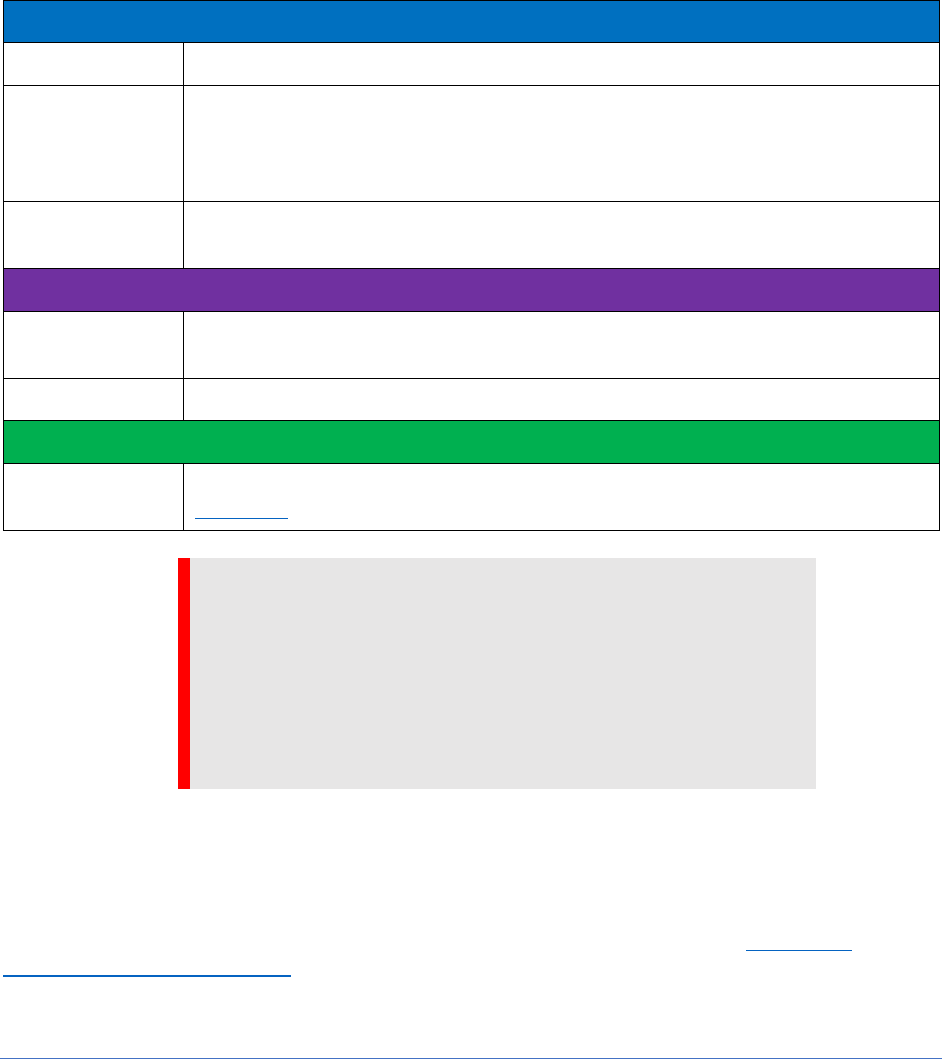
PCMS Functional Requirements 4
Furthermore, the 39 subsections within Sections 1 through 7 feature a color-coded table that documents in
detail the functions and requirements which support that specific task or activity. Each table documents:
Business/Organizational functions (divided into process activities, use cases/user stories, and
statutory duties/other obligations)
Application requirements (divided into application capabilities and data exchanges)
Data Management requirements (data needs).
The sample table below illustrates the look and describes the content of each color-coded table in the 39
subsections within Sections 1 through 7:
Business/Organizational
Process Activities
The steps and/or processes that support the capabilities.
Use Cases /
User Stories
A description, presented from a user’s point of view, of what the user needs to
accomplish for the day-to-day process activities. For these functional requirements, a user
is any person in the prosecutor’s office who uses the PCMS; it may be an attorney or
other staff depending on the use case.
Statutory Duties /
Other Obligations
The rules and/or standards used to guide the day-to-day office activities.
Application
Application
Capabilities
The functions that an application must/should perform in order to support the
capabilities and operational needs of the agency.
Data Exchanges
Data exchanges that support the needs of the function.
Data Management
Data Needs
The data requirements needed to support the capability identified in data groups.
Appendix D provides the list of data elements within each data group.
NOTE: General administrative functions, such as human resources,
finance and payroll, are not unique to a prosecutor’s office; therefore,
this document does not address them. Similarly, this document does
not address technical infrastructure requirements because, in most
cases, these functions are provided by a separate entity within the city,
county, or state where the prosecutor’s office resides.
Terms and Definitions
The legal profession has many special terms and its own vocabulary. Many of these terms and definitions
vary regionally and by state. Likewise, the information technology community has its own language. This
document attempts to navigate these differences based on the consensus of the subject matter experts who
reviewed this document. Special terms are defined when first used and are included in Appendix A,
Document Terms and Definitions.
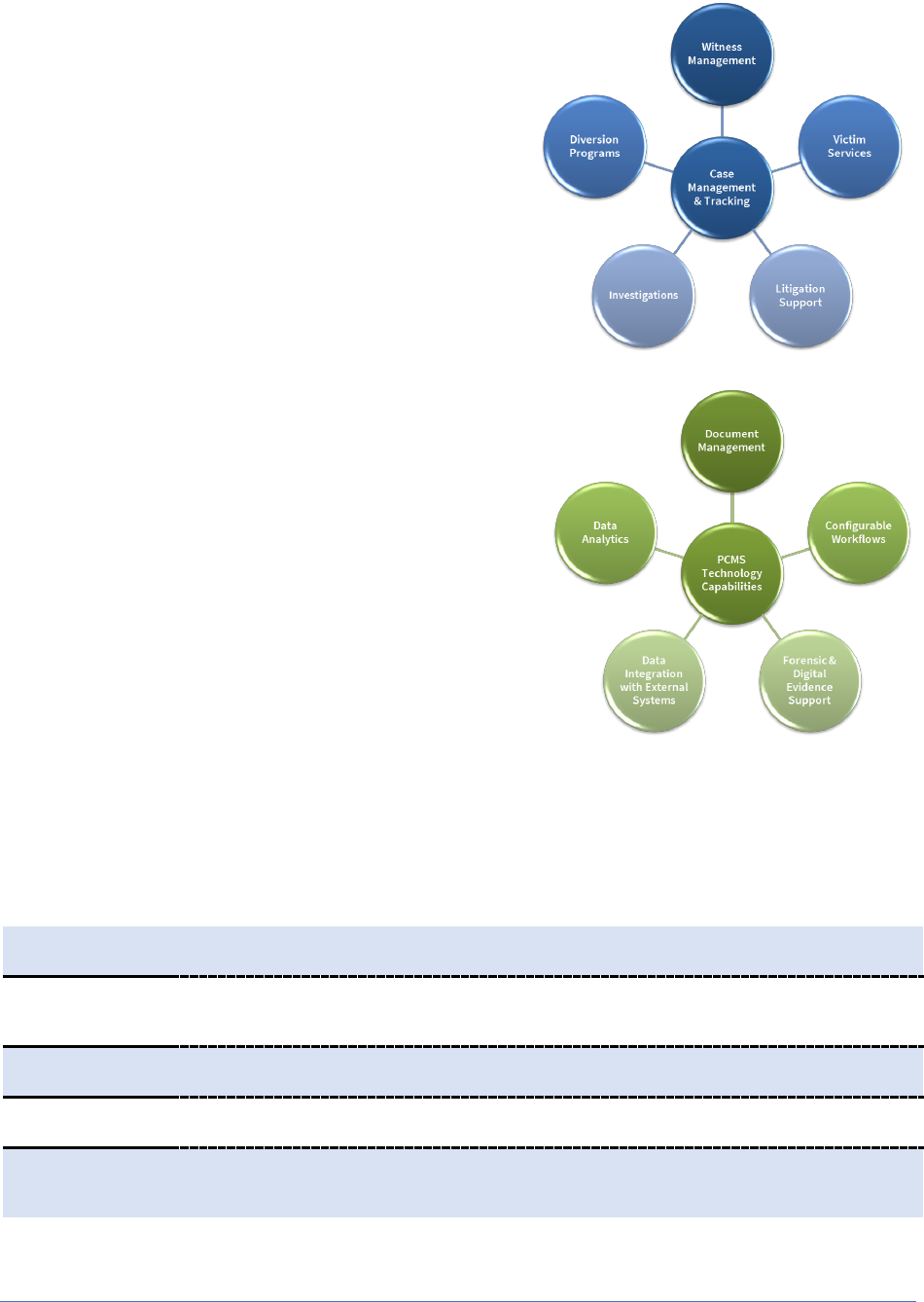
PCMS Functional Requirements 5
Overview of Prosecutor Case Management Systems
A PCMS is a collection of capabilities contained in one or
more software applications that address the functional
requirements of a prosecutor’s office. Case management
and tracking remain the core activities supported with other
business service activities—the case support services—to
enable prosecutors to work more efficiently and reduce case
timelines and backlogs (as shown in the figure 1).
Similarly, technological advancements enable effective
information sharing, increased accuracy, and reduced
paperwork, and eliminate redundant data entry (as shown in
the figure 2). These also contribute to more effective case
management and reduced case timelines and backlogs.
An ideal PCMS satisfies the functional requirements of a
prosecutor’s office and advances efficiency, accuracy, and
case management performance. The PCMS efficiently
streamlines a prosecutor office’s capability to collect, store,
retrieve, edit, archive, and view information, records,
documents, or files required of prosecutors to fulfill their
responsibilities. Additionally, it may support the automated
exchange of data with justice partner agencies to support
investigations or prosecutions.
While all prosecutors handle criminal cases, and this process
is the focus of the first three sections of this document,
some prosecutors also handle a variety of other special case
types, including certain civil matters. Section 4 addresses
these special case types.
Case Tracking and Management: Core Business Activities
A case is the principal unit of work within the prosecution process. It typically encapsulates a single criminal
incident, which can have one or more defendants with one or more criminal charges. There are multiple
types of cases that may have different case tracking requirements and include different components. Typical
case types include:
Felony
A case where the potential sentence upon conviction is incarceration of one year or longer.
Misdemeanor
A case involving less serious crimes generally punishable by fine, penalty, forfeiture, or
imprisonment for less than one year in a local or county jail.
Juvenile
A case involving a minor.
Infraction
A case involving a minor offense (e.g., traffic violations) and usually results in a fine.
Special
Special situations or cases, such as use of a Grand Jury, Extraditions, and Appeals, align
with these requirements and are addressed in Section 4, Special Case Types.
Figure 1
Figure 2
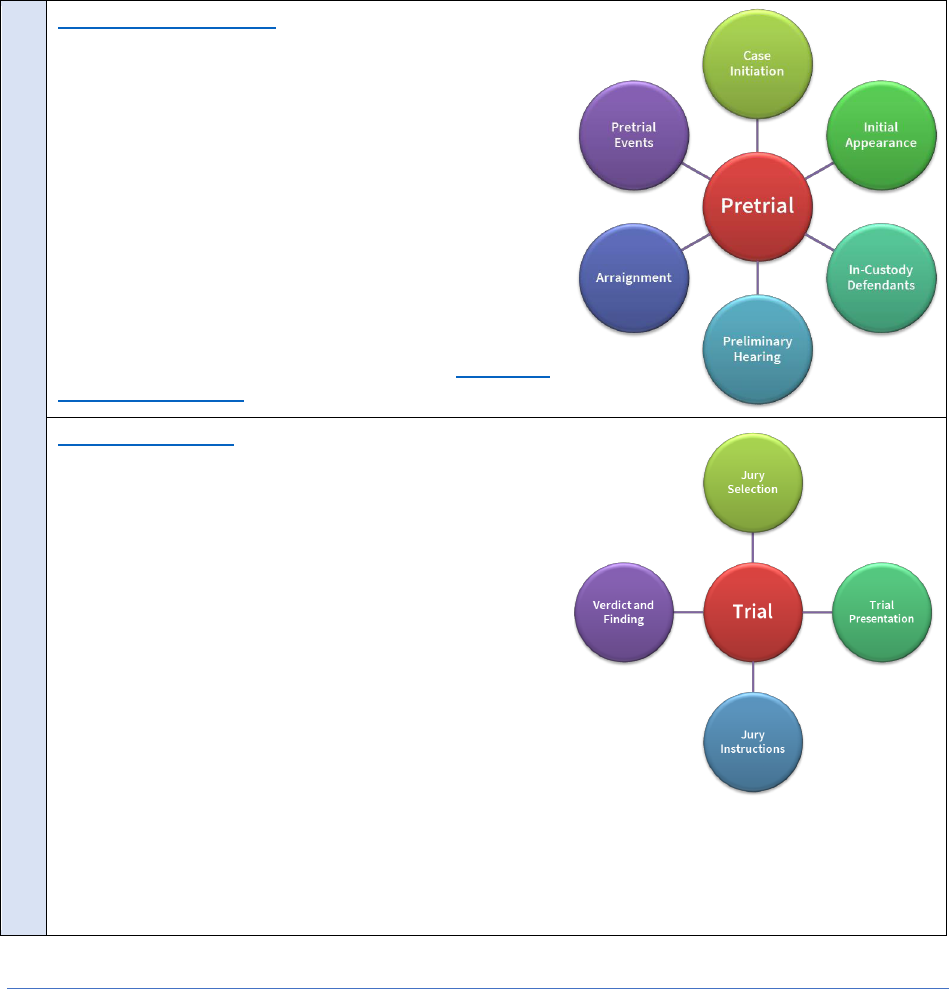
PCMS Functional Requirements 6
A key design requirement of the PCMS is to determine the organizational structure of the case—whether it
tracks single or multiple defendants. The PCMS must be able to collect and organize different case
information types, whether users enter case data or it’s imported from other sources. It must provide a
means to —
create a case
update and maintain status and activity information related to the case
accommodate multiple conclusions or outcomes.
High-level Outline of PCMS Functional/Nonfunctional Requirements
The following table is a high-level outline before we delve into the details. The spokes that radiate from the
center represent subsections within each main section. Click on the blue headers to move directly to that
section, and use this as your roadmap to this document.
FUNCTIONAL REQUIREMENTS
SECTION 1: PRETRIAL
Pretrial functional requirements are the business
functions that take place prior to a trial and include
case initiation (screening), initial appearance,
preliminary hearing, arraignment, in-custody
defendants, and pretrial events (motions, hearings,
conferences, meetings, and other scheduled activities).
In states that require the use of a grand jury, the grand
jury functions are included in the pretrial phase. The
specific activities associated with the pretrial function
vary depending on the type of case being prosecuted.
The process described in this document follows that of
an adult felony case. Other case types (misdemeanors,
infractions, juvenile) may follow variations of this
process; those variations are documented in Section 4,
Special Case Types.
SECTION 2: TRIAL
In a criminal trial, a jury or judge examines the evidence
presented by a prosecutor to determine whether a
defendant has committed a criminal offense. The
burden of proof that a prosecutor must exceed is
“beyond a reasonable doubt.” A trial is the government's
opportunity to present evidence and arguments against
the defendant. While a defendant has no obligation to
present a defense, a trial does allow the defense a
chance to refute the government's evidence, and to
offer its own evidence or arguments in some cases.
After both sides present their closing arguments, the
jury or court considers whether to find the defendant
guilty or not guilty of the crime(s) charged.
A trial consists of six main parts: 1) jury selection, 2)
opening statements, 3) presentation of the prosecution’s case, including physical evidence and
witness testimony, 4) presentation of the defense case, if any, including potential evidence and
testimony, 5) jury instructions, and 6) verdict and finding. The PCMS capabilities needed for the
trial include jury selection, trial presentation, jury instructions, and verdict and finding.
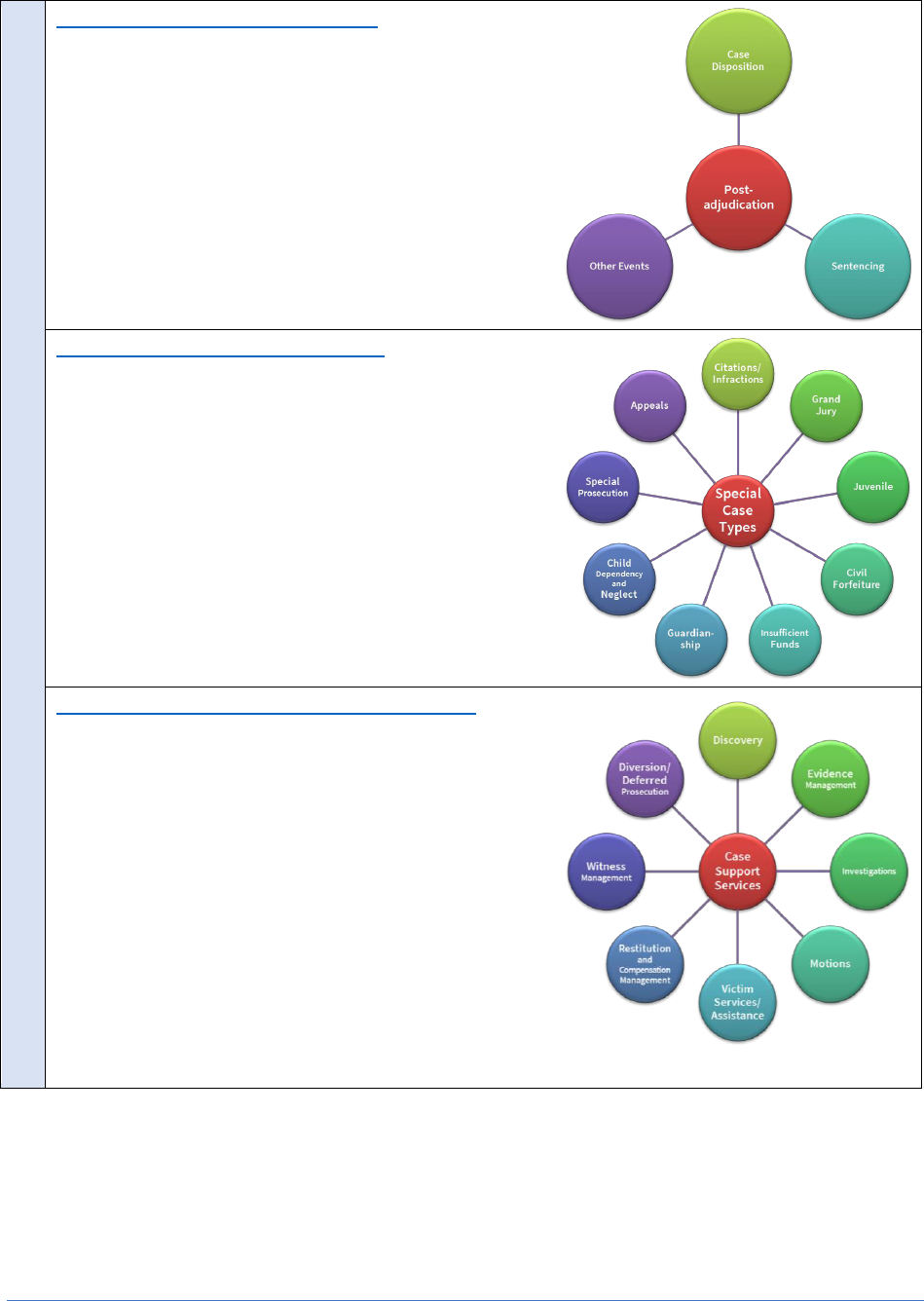
PCMS Functional Requirements 7
FUNCTIONAL REQUIREMENTS
SECTION 3: POST-ADJUDICATION
Post-adjudication functions include dispositions,
sentence hearings, and post-adjudication
information sharing and event tracking (verdict and
finding).
SECTION 4: SPECIAL CASE TYPES
The PCMS capabilities needed for special case types
include—
citations/infractions
grand jury
juvenile cases
civil forfeiture
insufficient funds
guardianship
child dependency and neglect cases
special prosecutions
appeals
SECTION 5: CASE SUPPORT AND SERVICES
Case support functions are those tasks and activities
required to successfully prosecute cases but which fall
outside of the case-tracking process. These functions
span the entire life of the case and are important to
successfully manage the case through its lifecycle. They
are:
Discovery
Evidence management
Investigations
Motions
Victim services/assistance
Restitution and compensation management
Witness management
Diversion/deferred prosecution
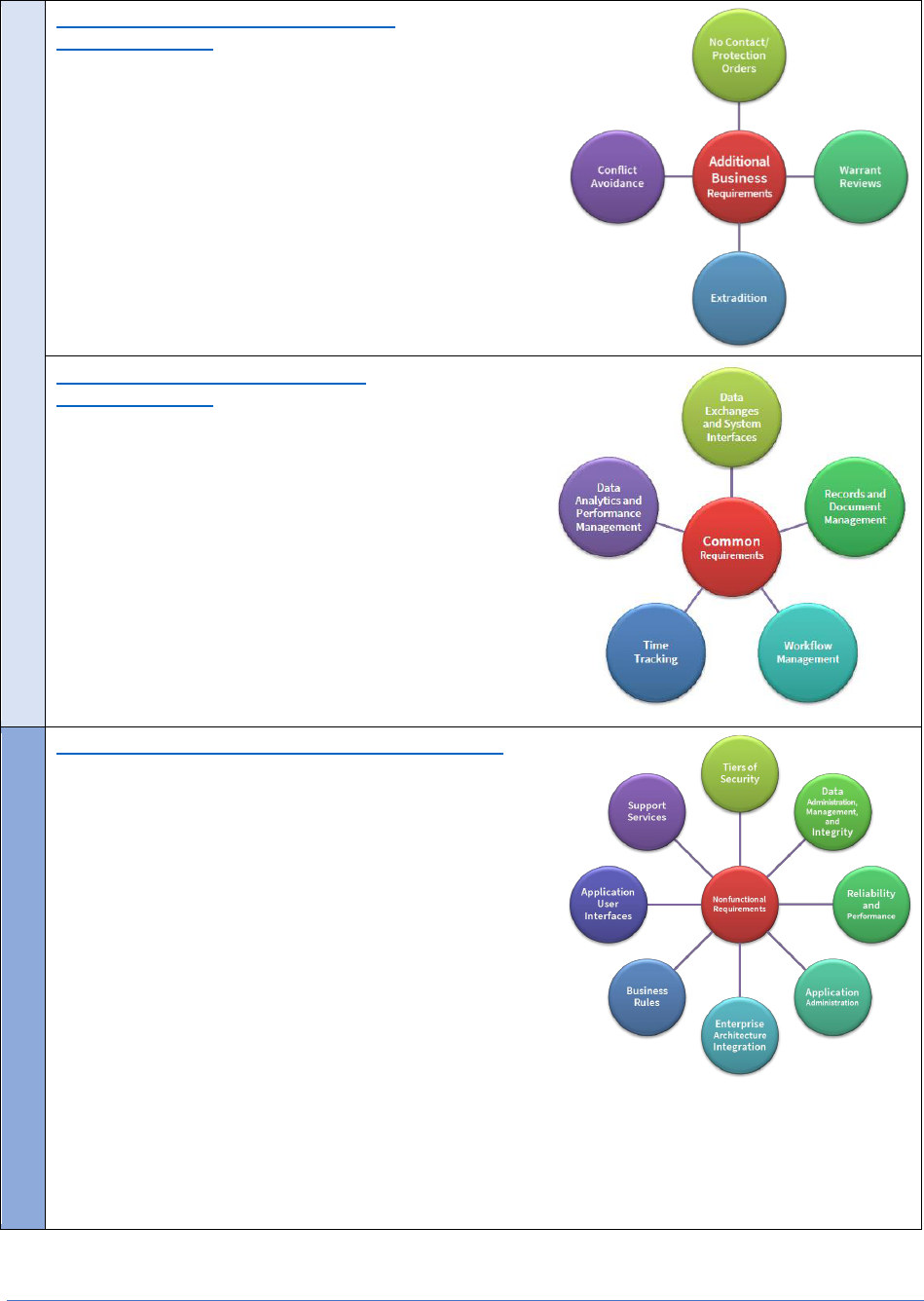
PCMS Functional Requirements 8
FUNCTIONAL REQUIREMENTS
SECTION 6: ADDITIONAL BUSINESS
REQUIREMENTS
Additional business requirements are prosecutor case
management functions and tasks that fall outside the
adult criminal and juvenile case prosecution activities.
They are:
No contact/protection orders
Warrant reviews
Extradition
Conflict avoidance
SECTION 7: COMMON BUSINESS
REQUIREMENTS
Common requirements are those tasks and activities
that support functional areas of the prosecutor’s office.
These capabilities are used throughout the life-cycle of
a case to exchange information, and to manage
documents, case records, workflow and staffing
resources, as well as other prosecution
responsibilities. Common requirements include:
Data exchanges and system interfaces
Records and document management
Workflow management
Time tracking
Data analytics and performance
management
NONFUNCTIONAL REQUIREMETNS
SECTION 8: NONFUNCTIONAL REQUIREMENTS
Nonfunctional requirements describe the capabilities
needed to manage the environment of a business
system. These capabilities, which are used by system
and database administrators, address the deployed
environment of the business application. They are:
Tiers of security
Data administration, management, and
integrity
Reliability and performance
Application administration
Enterprise architecture integration
Nonfunctional requirements also describe the
capabilities that are needed to manage the PCMS
application. These capabilities address the business application itself and are used by the
application administrator:
Business rules
Application user interfaces
Support services

PCMS Functional Requirements 9
Section 1: Pretrial
1a. Case Initiation
The case management process in the PCM begins when a
criminal case is initiated.
Business/Organizational
Process Activities
A criminal case usually starts when a prosecutor evaluates a law enforcement case. Such
cases consist of all available and relevant information pertaining to person(s) involvement
in a criminal incident or event and may include any or all of the following documentation:
arrest report, incident report, victim and witness statements, investigative notes, citation,
probable cause statement or affidavit, physical evidence, test results, etc.
After reviewing all available documentation, the prosecutor determines if there is sufficient
evidence to support the filing of charges, what charges will be filed, and that there is a
strong likelihood of conviction.
For felony cases, prosecutors are the primary legal authority for determining if charges
should be filed and the offender prosecuted.
iv
Within the context of this document, the
presentation of charges by law enforcement is referred to as charge referral. Once a
criminal charge is referred, the prosecutor has authority to determine whether the case
should proceed to prosecution. Prosecutors need all relevant and available information
about the incident, arrest, and/or warrant in order to make a filing decision.
Case initiation ends when the prosecutor files a case in court, diverts a case, or dismisses
a case. When filing a case with the court, a prosecutor will use a legal form. The three
most common legal forms are Informations, Complaints, and Indictments. An
Information is filed in a general jurisdiction court; a Complaint is filed in a limited
jurisdiction court; and an Indictment is used to initiate a case by a grand jury. For purposes
of this document, these various forms are called charging documents.
Depending on the jurisdiction, charges may be filed with the court electronically or on
paper. The form of the charging document is dictated by state statute, or the jurisdiction’s
court rule. If evidence is insufficient to result in the likelihood of conviction, the prosecutor
may decline to file charges against the suspect. This is often referred to as a no file or
nolle prosequi. The charging document in a juvenile case may be called a petition.
Use Cases /
User Stories
The case initiation process consists of the following activities. The user —
Creates a case and enters information to uniquely identify the case.
Enters case participants, then compares and verifies those names based on what
is already in the system to reduce redundant information.
Adds charges and counts based on an evaluation of the evidence presented.
Identifies the lead charge, if appropriate, for a given defendant. This is typically
the most serious charge.
May place a hold on 1 or more charges in a case.

PCMS Functional Requirements 10
Adds arrest, booking, citation, custody, bail, and bond information for each
defendant OR acquires this information electronically from the law enforcement
agency or court (from the initial appearance) and verifies the information prior to
adding it.
Enters case (user-definable) categorical information.
Enters case information: arrest, in-custody, citation or summons, warrant, or
juvenile.
Links related cases, defendants, and participants, and then designates the nature
of the relationship between cases.
Enters data to link the defendant, case, and charges to other criminal justice
information systems (includes a unique person identifier, and identifiers for arrest,
charge, case).
Assigns prosecutors and other office personnel to a case and/or enters all
persons associated with a case and indicates their role on the case.
The PCMS includes views to provide users with the information they need to review
charges or warrants and decide how to proceed with the case. The user then—
Needs to ensure case information is current, accurate, and complete before filing.
Creates all documents based on the jurisdiction’s procedure.
Files the case with the court within court procedural time constraints.
Statutory Duties /
Other Obligations
Based on case category and appearance requirements, the timely filing of cases is
required. For example, offenders who are arrested and in custody need to be brought
before a judge within a short period of time,
v
and offenders issued a summons are
required to appear in court on the date set in the summons.
Applications
Application
Capabilities
To support case initiation, the PCMS—
Should allow the automated entry of case information from law enforcement and
court systems via information exchanges. Furthermore, the PCMS must allow the
user to—
o validate information received electronically.
o accept/reject information from information exchanges.
o add identifiers needed to allow dispositions to be associated to the law
enforcement criminal history records at the conclusion of the case.
Must automatically search itself for pre-existing case records that can be used to
identify and link together multiple individuals and events.
Must allow the user to merge case or defendant records if duplicates are found.
Should automatically notify user if pre-existing case is no longer in warrant status
and a court date is set.
Should prompt users when cases, defendants, or participants already exist in the
system that relate to a new case (e.g., defendants involved in other cases, aliases
identified by the Pretrial Services unit), followed by a user-initiated search for pre-
existing defendants, participants, and defense attorneys whom the user can apply
to the current case, if appropriate, to avoid duplicate data entry (e.g., using
participant names, addresses, and other identifiers).

PCMS Functional Requirements 11
Must offer the ability to add and maintain—
o attorney and staff names and contact information
o case information
o state statute and ordinance charges.
Should automatically notify prosecutors handling the pre-existing case of any held
charges, new charges, or cases related to existing defendants.
Should automatically inform prosecutors reviewing a new case if any participants
are involved in other cases.
Must generate and assign separate identifiers for each defendant or receive
identifiers from another criminal justice agency.
Must allow the user to capture or allow entry of other identifiers for other case
participants (e.g., prosecutor, defense attorney, corrections, law enforcement) and
establish relationships of participants to the case.
Must generate and assign an internal case number for each case using locally-
defined format and procedures (e.g., separate case number for each case the
prosecutor reviews).
Must be capable of recording and indexing the case by the court-assigned case
number.
Must associate each defendant with a case and identify potential codefendants
and their respective case numbers.
Must allow the user to enter each charge and count to produce charging
documents.
Should allow the user to identify the lead charge, if appropriate, among a group of
charges for a given defendant.
Must enable data entry of required elements for arrest, booking, citation, bail, and
bond information for each defendant OR acquire this information from an existing
court case management system to import the data automatically.
Should generate a case caption (i.e., a short phrase that identifies each case and
includes prosecution and defendant name) from individual names and other
information. The case caption is produced from all filing exchanges and
documents.
Should allow the user to enter reasons for initiation (e.g., new filing, case
transferred from another jurisdiction, case bifurcated, previously closed case that
has been reopened, de novo appeal, etc.).
Must track and provide reports and notifications on case status, defendant status,
and charge status.
Must track which agency initiated the investigation or referred the charges.
Must allow the user to create all documents needed for filing based on the records
and document management functionality.
Should support electronic filing of charging documents (e.g., complaint,
indictment, etc.) and transfer designated data from the PCMS to the court case
processing system.
Should accept and handle acknowledgement from the court that the case filing
was received and accepted or produce an error message if not accepted.

PCMS Functional Requirements 12
Should enable cases to be organized in any manner that supports case
management strategies like differential case management (i.e., different
categories of cases are processed differently, such as in time-sensitive filings,
cases processed under different rules or time standards, specific judicial
assignment for specific types of cases) and other case management methods
(users enter differential case management parameters and time standards into
code translation tables).
Should allow users to designate the nature of the relationship between cases
(e.g., codefendants, multiple cases against same defendant).
Should allow a given participant to have multiple roles (e.g., victim and
complainant), both within and across cases.
Should support the creation of alerts pertaining to each case and defendant, such
as the need for action or time constraint (speedy trial).
Should allow users to defer or decline prosecution based on prosecutor review
and decision.
Data Exchanges
Data exchanges that support case initiation include:
Incident reports
Arrest reports
Booking reports
Summons
Evidence reports
Docketing/calendar information
Charge filings
Data Management
Data Needs
During case initiation, the user will need to enter relevant information that is available,
validate information from data exchanges, and match and update existing person
information. Data required for case initiation include elements from the following data
groups:
vi
Case
Person
Defendant details
Victim
Witness
Incident
Arrest
Booking
Evidence
Warrant

PCMS Functional Requirements 13
1b. Initial Appearance
In felony cases, the Initial Appearance is the first time a defendant appears before a judicial officer. (Other
terms may be used to describe this event, such as Advisement.) At the initial appearance, the court informs
the defendant of the charges being brought, the potential penalties, and his or her constitutional rights.
These include the right to remain silent, the right to bond, the right to confront and cross-examine witnesses,
and the right to be represented by an attorney and the availability of a public defender if the accused cannot
afford an attorney. The court may present the defendant with a copy of the formal charging document.
The timing of the initial appearance depends on whether the defendant is in custody. If the defendant is in
custody, the initial appearance must occur without significant delay (usually less than 72 hours). For
defendants not in custody, the initial appearance may be scheduled at a time that is more convenient for the
court. When a defendant is not in custody, the initial appearance may also be combined with other
adjudication activities.
For misdemeanors, the Initial appearance is often combined with the arraignment, where the defendant
enters a plea, a settlement conference or other pretrial events or activities. During the initial appearance,
the judge may order a variety of actions, including setting bail, releasing a defendant from custody, detaining
a defendant, ordering fingerprints be taken, appointing counsel to the defendant, setting next court
appearance, and judicial assignment.
Business/Organizational
Process Activities
The PCMS must track the activity and event, participants, locations, schedule, and outcome
of the initial appearance. The initial appearance serves these purposes:
Informs the arrestee of criminal charges in a timely manner.
Allows the defendant to enter a plea.
Initiates the court case.
Establishes the need for an attorney.
In some cases, establishes bond and bail conditions.
Schedules further court events.
Use Cases /
User Stories
To carry out these functions, the user—
Obtains and organizes case information (e.g., charge information, incident and
arrest reports, evidence, statements, etc.).
Ensures the defendant has a copy of charges or indictment.
Records the result of the arraignment (in misdemeanor cases, the court may ask
the defendant to enter a plea of guilty, not guilty, or no contest to the charges).
Records any bail amount requested and imposed, bail conditions, and any other
court-imposed restrictions.
Records and tracks any no contact orders that were imposed.
Schedules events and tracks information on each scheduled event.
Views and updates attorney and staff calendars.
Reviews the court schedules to update attorney and staff calendars.
Complies with speedy trial standards and other deadlines related to case
processing.

PCMS Functional Requirements 14
Statutory Duties /
Other Obligations
A prosecutor should be present at the initial appearance and the PCMS must track all
information created by the initial appearance.
Applications
Application
Capabilities
To support initial appearances, the PCMS—
Must track initial appearance information, including the indictment and charge
information, along with any supporting evidence and incident/arrest information.
Must record:
o the charges
o the plea, if entered at initial appearance
o defendant counsel
o bail conditions
o bond status
o no contact orders
Must allow users to record or obtain from the court system all dates of further
proceedings, such as the arraignment, preliminary hearings, motions, pretrial
conference, and the trial date.
Must track the history of case events, including results of the event.
Must use or integrate with staff and court calendars in order to create and view
events and tasks assigned to individuals.
Must provide alerts and notifications to ensure that the users understand who is
required at each event, what artifacts (e.g., evidence, testimony, etc.) they need for
each event, and when and where each event is to take place. This includes:
o event status (pending, complete, overdue)
o logging receipt of documents
o meetings
o correspondence
o work products
o task assignments
o deadlines
o contacts
Should include a notice of scheduling conflicts.
Should allow changes to events without affecting the historical records of the case.
Should track the outcomes of each event.
Should track the time remaining before the case must be brought to trial (speedy
trial).
Data Exchanges
Data exchanges that support initial appearances include:
Charge filings
Plea agreement (if defendant enters a plea)
Docketing/calendar information
Court minutes

PCMS Functional Requirements 15
Data Management
Data Needs
Data required for initial appearances include elements from the following data groups:
Case
Person
Defendant details
Victim
Witness
Events
Bail and bond
1c. In-Custody Defendants
Handling in-custody defendants is a special case of initial appearance in that—
1) the defendant has a constitutional right to appear before a judicial officer regarding his/her
detention within a “reasonable” period of time as established by law
vii
and
2) the prosecutor may not be aware of the defendant’s charges because the arrest and detention process
occurs before the arresting agency has referred charges to the prosecutor for review.
Functional requirements for in-custody defendants are the same as for initial appearance (Section 1b,
above), except that the time period may be condensed and the case may be initiated by the court in response
to the arrest and right to a judicial hearing.

PCMS Functional Requirements 16
1d. Preliminary Hearing
In felony cases, probable cause must be established in order to have the case proceed to trial. Probable
cause can be established several ways. The most common is by preliminary hearing. In many states, felony
preliminary hearings are held in the lower courts. Once probable cause is determined, the case is “bound
over” to the general jurisdiction or trial court for further proceedings. Other mechanisms for establishing
probable cause are the actions of the Grand Jury by Indictment. (See Grand Jury under Section 4: Special
Cases.) In some states, using a Grand Jury is a requirement; in others, it is not required and is rarely used.
Business/Organizational
Process Activities
The PCMS must track the activity and event participants, locations, schedule, outcomes,
and help the users coordinate the documents and materials required for the preliminary
hearing/examination is a proceeding, after a felony charge has been filed by the
prosecutor, to determine whether there is probable cause to proceed against the
defendant.
Use Cases /
User Stories
To perform these functions, the user—
Obtains and organizes case information (e.g., charging documents, incident and
arrest reports, evidence, statements, etc.).
Records the results of the plea in cases where the defendant changes his or her
plea.
Schedules events and tracks information about the preliminary hearing (e.g.,
deadlines for submission of documents and exhibits, completion of diversion
programs), including:
o event date, time, identification, and location
o participants in the event (e.g., defendant, victims, witnesses, interpreters)
o security and data integrity requirements
o activities initiated by the event (e.g., forms and subsequent events)
o periods associated with the event (e.g., deadlines for form issuance or
initiation of next event)
o cross-references to case, hearing, and other information
Views and updates attorney and staff calendars.
Reviews the court schedules to update attorney and staff calendars.
Reviews the number of cases/tasks assigned to each employee.
Assigns and transfers cases and tasks attorneys and other office staff, based on
resource availability, to ensure participation in court events.
Manages workloads to ensure that all activities can be completed in a timely and
effective manner.
Complies with speedy trial standards and other deadlines related to case
processing.
Prepares for the preliminary hearing — the user may search, view, and print
information on each calendared event (i.e., proceedings in which arguments,
witnesses, evidence, and exhibits are heard and examined by a judge, including
court events such as preliminary hearings, trials, motion hearings, and
sentencing hearings, as well as other judicial proceedings, such as conferences
aimed at plea agreement), including:

PCMS Functional Requirements 17
o event type
o scheduled and actual dates and times
o judge
o location (e.g., courtroom type and its location)
o prosecutor, defense attorneys
o results
o cross-reference to case, defendant, other participant, and other information
Statutory Duties /
Other Obligations
Most states have a court rule or statute that requires a defendant to be notified of
charges within a specific amount of time.
viii
Applications
Application
Capabilities
To support pretrial events, the PCMS—
Must track arraignment information, including the indictment and charging
documents, along with any supporting evidence and incident/arrest information.
Must collect the plea.
Must track the schedule for each court event per case, per participant.
Must track the history of the preliminary hearing, including results of the hearing.
Must use or integrate with staff and court calendars in order to create and view
events.
Must track tasks assigned to individuals.
Must provide alerts and notifications to ensure that the users understand who is
required at each event, tasks that need to be completed, what artifacts they
need for each event, and when and where each event is to take place. This
includes:
o event status (pending, complete, overdue)
o logging receipt of documents
o meetings
o correspondence
o work products
o task assignments
o deadlines
o contacts
Should provide notice of scheduling conflicts.
Should allow changes to events without affecting the historical records of the
case.
Should track whether a defendant remains in custody and if so, highlight the
time remaining before the case must be brought to trial.
Data Exchanges
Data exchanges that support preliminary hearing include:
Supplement reports
Charge filings
Plea agreement (if defendant enters a plea)

PCMS Functional Requirements 18
Docketing/calendar information
Court minutes
Discovery information
Hearing request
Data Management
Data Needs
Data required for pretrial events include elements from the following data groups:
Person
Case
Defendant details
Events
Charges
Pleas
Witnesses

PCMS Functional Requirements 19
1e. Arraignment
In a felony case, the arraignment occurs after the preliminary hearing once the case has been bound over to
the trial or general jurisdiction court. An arraignment includes the advisement of charges and the entry of a
plea. For misdemeanor cases held in a limited jurisdiction court, the arraignment may be held in conjunction
with the first appearance. The defendant will enter a plea of guilty, not guilty, or no contest. Provisions such
as bail and/or release may be reviewed at the arraignment, even if they have been previously addressed. The
court can also schedule further proceedings, such as motions hearings, pretrial/settlement conferences, and
setting a trial date.
Business/Organizational
Process Activities
The PCMS must track the activity and event, participants, locations, schedule, and outcome
of the arraignment. The arraignment serves the following purposes:
The judge will explain the charges.
The judge will explain the defendants’ rights.
The defendant enters a plea.
In some cases, the court establishes bond and bail conditions.
The court may schedule additional court events.
Use Cases /
User Stories
To perform arraignment functions, the user—
Obtains and organizes case information (e.g., charging documents, incident and
arrest reports, evidence, statements, etc.).
Ensures the court has a copy of charges or indictment.
Records the result of the arraignment when the court will ask the defendant to
enter a plea of guilty, not guilty, or no contest to the charges.
Records any bail amount, bail conditions, and any other court-imposed restrictions.
Schedules events and tracks information on each scheduled event.
Views and updates attorney and staff calendars.
Reviews the court schedules to update attorney and staff calendars.
Complies with speedy trial standards and other deadlines related to case
processing.
Statutory Duties /
Other Obligations
A prosecutor should be present at the arraignment and the PCMS must track all information
created by the arraignment.
Applications
Application
Capabilities
To support arraignments, the PCMS—
Must track arraignment information, including indictment and charge information,
along with any supporting evidence and incident/arrest information. As such, the
PCMS must:
o retain identification information for cases filed in limited and general jurisdiction
courts.
o record the charges.
o record the plea.
o record defendant counsel.

PCMS Functional Requirements 20
o collect bail conditions.
o collect bond status.
Must allow users to record or obtain from the court system all dates of further
proceedings, such as the arraignment, preliminary hearing, motions, pretrial
conference, and the trial date.
Must track the history of case events, including results of the event.
Must use or integrate with staff and court calendars in order to create and view
events and tasks assigned to individuals.
Must provide alerts and notifications to ensure that the users understand who is
required at each event, what artifacts (e.g., evidence, testimony, etc.) they need for
each event, and when and where each event is to take place. This includes:
o event status (pending, complete, overdue)
o logging receipt of documents
o meetings
o correspondence
o work products
o task assignments
o deadlines
o contacts
Should include a notice of scheduling conflicts.
Should allow changes to events without affecting the historical records of the case.
Should track the outcomes of each event.
Should track the time remaining before the case must be brought to trial (speedy
trial).
Data Exchanges
Data exchanges that support arraignment include:
Charge filings
Plea agreement (if defendant enters a plea)
Docketing/calendar information
Court minutes
Data Management
Data Needs
Data required for arraignment include elements from the following data groups:
Case
Person
Defendant details
Victim
Witness
Events
Bail and bond

PCMS Functional Requirements 21
1f. Pretrial Events
Pretrial events cover a range of activities and events that affect the course of a case, e.g., bail hearings, plea
negotiations, diversion program evaluations, witness interviews, etc. The PCMS must accommodate
collecting and reporting information for the activities and events that could occur before a case moves to trial.
These include, but are not limited to:
Pretrial conferences
Motion hearings
Other meetings, court events, and scheduled activities
Business/Organizational
Process Activities
The PCMS must track the activity and event participants, locations, schedule, outcomes,
and help the users coordinate the documents and materials required for the activity or
event.
Examples of business and organizational capabilities for pretrial events may include:
Pretrial court appearances help ensure the most effective and efficient
administration of justice. They allow prosecutors and defense attorneys the
opportunity to review evidence and frequently negotiate pleas, explore diversion
options, recommended sentences, or prepare for trials. Frequently, these
appearances result in motions drafted by the parties to be reviewed by a judge
at a pretrial hearing.
Pretrial hearings—e.g., omnibus and motion hearings—enable prosecutors and
defense attorneys to file any number of pretrial motions that seek to admit or
exclude evidence or otherwise shape the case proceedings. For example,
motions to suppress statements or evidence, motions for access to additional
discovery, motions for change of venues, etc. The outcome of a case often
hinges on the results of these motions and the hearings that accompany them.
Use Cases /
User Stories
To perform these functions, the user—
Obtains and organizes case information (e.g., charge information, incident and
arrest reports, evidence, statements, etc.).
Records the results of the plea, in those cases where the defendant changes his
or her plea.
Records any bail and bond amount, bail conditions, and any other court-
imposed restrictions.
Schedules events and tracks information on each event (e.g., deadlines for
submission of documents and exhibits, completion of diversion programs),
including:
o event date, time, identification, and location
o participants in the event (e.g., defendant, victims, witnesses, interpreters,
defense attorney)
o creates subpoenas
o security and data integrity requirements
o activities initiated by the event (e.g., forms and subsequent events)
o periods associated with the event (e.g., deadlines for form issuance or
initiation of next event)
o cross-references to case, hearing, and other information

PCMS Functional Requirements 22
Views and updates attorney and staff calendars.
Reviews the court schedules to update attorney and staff calendars.
Reviews the number of cases/tasks assigned to each employee.
Assigns and transfers cases and tasks attorneys and other office staff, based on
resource availability, to ensure participation in court events.
Manages workloads to ensure that all activities can be completed in a timely and
effective manner.
Manages tracking, preparation, and redaction of initial discovery.
Complies with speedy trial standards and other deadlines related to case
processing.
Prepares for each event — the user may search, view, and print information on
each calendared event (i.e., proceedings in which arguments, witnesses,
evidence, and exhibits are heard and examined by a judge, including court
events such as preliminary hearings, trials, motion hearings, and sentencing
hearings, as well as other judicial proceedings, such as conferences aimed at
plea agreement), including:
o event type
o scheduled and actual dates and times
o judge
o location (e.g., courtroom type and its location)
o prosecutor, defense attorneys
o results
o cross-reference to case, defendant, other participant, and other information
Statutory Duties /
Other Obligations
It is the responsibility of the prosecutor to establish and monitor case preparation,
timeline management, and coordinating the state’s witnesses. The statutory rules related
to pretrial events are in place to ensure speedy and fair administration of justice.
Therefore, it is important that events are tracked, managed, and recorded.
Applications
Application
Capabilities
To support pretrial events, the PCMS—
Must track arraignment information, including the indictment and charge
information, along with any supporting evidence and incident/arrest information.
Must collect the plea.
Must collect and track defense counsel.
Must collect, prepare and track discovery.
Must collect and track bail status.
Must track the schedule for each court event per case, per participant.
Must create subpoenas for each witness.
Must track the history of court events per case, including results of the event.

PCMS Functional Requirements 23
Must use or integrate with staff and court calendars in order to create and view
events.
Must track tasks assigned to individuals.
Must provide alerts and notifications to ensure that the users understand who is
required at each event, tasks that need to be completed, what artifacts they
need for each event, and when and where each event is to take place. This
includes:
o event status (pending, complete, overdue)
o logging receipt of documents
o meetings
o correspondence
o work products
o task assignments
o deadlines
o contacts
Should provide notice of scheduling conflicts.
Should allow changes to events without affecting the historical records of the
case.
Should track whether a defendant remains in custody and if so, highlight the
time remaining before the case must be brought to trial.
Data Exchanges
Data exchanges that support pretrial events include:
Supplement reports
Charging filings
Docketing/calendar information
Court minutes
Discovery information
Motions/orders from events
Hearing request
Data Management
Data Needs
Data required for pretrial events include elements from the following data groups:
Person
Case
Defendant details
Events
Charges
Pleas
Witnesses
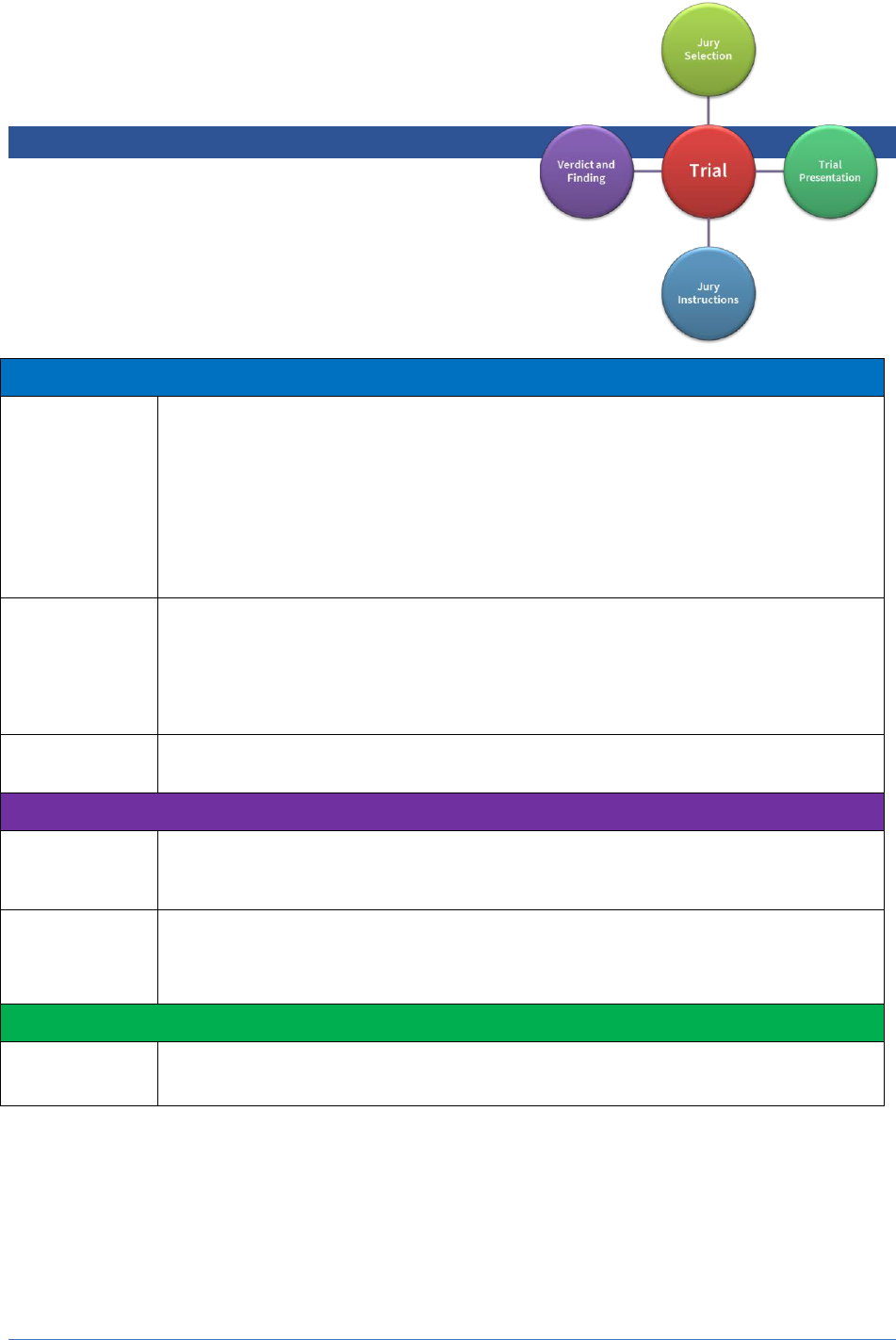
PCMS Functional Requirements 24
Section 2: Trial
2a. Jury Selection
The primary purpose of the jury selection process is to
empanel a jury that is representative of the community
and does not have personal interests or prejudices for or
against a party to the extent that they cannot render a
verdict based upon the law and the facts.
Business/Organizational
Process Activities
The prosecutor—
May conduct pre-voir dire investigations of prospective jurors, such as criminal
history background checks.
Prepares for voir dire examination and questionnaire.
Manages the voir dire process by qualifying jurors to sit on the panel for the trial.
Individual jurors may be challenged for cause or peremptorily and disqualified
from the panel.
Use Cases /
User Stories
To perform these functions, the user—
Requests and receives background checks on prospective jurors.
Prepares voir dire examination.
Manages the voir dire process.
Statutory Duties /
Other Obligations
The rules used to guide the day-to-day activities for jury selection are receiving lists of
jurors, maintaining privacy of jurors’ identities, and investigate jurors.
Applications
Application
Capabilities
To support jury selection, the PCMS must support venire/panel for background
investigations of potential jurors, including: names, identifiers, addresses, work history,
etc.
Data Exchanges
Data exchanges that support jury selection include:
Jury lists
Criminal histories (i.e., Person Identity Histories)
Data Management
Data Needs
Data required for jury selection include elements from the following data groups:
Person

PCMS Functional Requirements 25
2b. Trial Preparation and Presentation
The prosecutor may rely on trial presentation capabilities to control, sort, index, and extract information in
support of cases going to trial, including, but not limited to, verbal and written statements, documents,
photos, audio, and video materials. Trial presentation capabilities enable the prosecutor to plan, organize,
and track testimony.
Business/Organizational
Process Activities
The steps a prosecutor may perform to prepare for presenting evidence at trial include:
Receive information from law enforcement and other sources.
Import information.
Index, sort, classify, and organize information.
Search for information.
Retrieve information and create reports based on a variety of criteria (by person,
date, issue, etc.).
Ad-hoc and on-demand information reporting.
Organize witnesses, evidence, and testimony.
Track introduction of evidence and testimony.
User Cases/
User Stories
To perform these functions, the user—
Receives and imports information.
Enters metadata related to the information to index, sort, classify, and organize the
information.
Uses search capabilities to retrieve and review information
Uses redaction and track changes as needed to present information to the jury.
Produces reports and presentations from the information based on a variety of
predetermined criteria: by person, date, issue, etc.
Creates ad-hoc and on-demand information reports.
Creates presentations of evidence and plans for testimony.
Statutory Duties /
Other Obligations
The prosecutor must manage information from electronic discovery or data forensics, and
organize and analyze the large quantities of data, documents, photos, video, and audio to
develop the best methods to present case materials.

PCMS Functional Requirements 26
Applications
Application
Capabilities
Trial presentation capabilities are designed to aid in the process of litigation and document
review, and generally include databases for organizing, searching, and reviewing discovery
evidence and materials, including interview transcripts, produced documents, photos,
audio, video, and correspondence for use as evidence or the entry of testimony.
The trial preparation and presentation capabilities must be able to—
Import data objects from outside sources.
Flag imported information with jurisdictional-defined coding.
Search and retrieve information based on persons, issues, critical documents,
documents for production, chronology reports, and witness testimony, and be able
to import transcripts.
Add on-demand keywords for persons, issues, etc.
The trial presentation software also must be able to run locally on a laptop PC for portability
at a trial.
Data Exchanges
Additional data exchanges for trial preparation and presentation may include:
Discovery information
Investigative reports
Evidence (audio, video, images, etc.)
Evidence analytical reports
Data Management
Data Needs
Data required for trial preparation and presentation include elements from the following data
groups:
Case
Person
Defendant details
Incident
Arrest
Victim
Witness
Evidence tracking
Artifact classification criteria: source, date/time, subject, objective

PCMS Functional Requirements 27
2c. Jury Instructions
At the conclusion of a jury trial and before a verdict is rendered, the judge will provide jury instructions. Jury
instructions are the rules and guidelines the judge gives the jury that include the set of legal standards the
jury will need to decide whether the defendant is guilty or not guilty.
Business/Organizational
Process Activities
Jury instructions are written with input and argument from the prosecution and defense.
However, the judge decides what legal standards should apply to the case based on the
criminal charges and the evidence presented during the trial. The judge then instructs the
jury on relevant legal principles and includes findings the jury will need to make in order to
arrive at certain conclusions. The jury instructions also define any crimes the jury may
consider based on the evidence presented at trial.
Use Cases /
User Stories
To perform these functions, the user—
Reviews the charges, evidence, facts, and other artifacts presented during the trial
in order to determine what jury instructions should be presented.
Creates proposed jury instructions from templates to provide to the judge to
determine what is included in the jury instructions.
Statutory Duties /
Other Obligations
The prosecutor provides the judge with recommended jury instructions, to include the
charges and legal precedents for each charge.
Applications
Application
Capabilities
The PCMS must provide a template for the jury instructions.
Data Exchanges
No additional data exchanges were identified for this function
Data Management
Data Needs
Data required for jury instructions include elements from the following data groups:
Person
Case

PCMS Functional Requirements 28
2d. Verdict and Finding
The verdict is the finding or decision of a jury or the court on one or more charges. The results of a criminal
trial—the verdict—are guilty, not guilty, hung jury, or case is dismissed with or without prejudice for each
charge. The verdict is recorded in the case file in the PCMS. If the verdict is hung jury, the prosecutor may
refile.
Business/Organizational
Process Activities
The jury is responsible for providing the verdict.
Use Cases /
User Stories
The user will record the verdict and findings in the disposition of a case.
Statutory Duties /
Other Obligations
The prosecutor should provide sufficient admissible evidence to support a verdict.
Applications
Application
Capabilities
To support verdict and finding, the PCMS must—
Track and manage the verdicts of all charges.
Allow the entry and/or import of disposition information, including the verdict.
Data Exchanges
Additional data exchanges may include:
Conviction orders
Court minutes
Data Management
Data Needs
Data required for verdict include elements from the following data groups:
Person
Case
Charge
Disposition

PCMS Functional Requirements 29
Section 3: Post-adjudication
3a. Case Disposition
Dispositions are the outcome of the charges filed against a
person. In criminal procedure, the judgment by a court or
jury resulting in an acquittal of a defendant or a guilty
verdict signals the end of the trial stage. Not all cases result
in a trial; therefore, the PCMS must track dispositions for
each charge and person throughout the case.
Business/Organizational
Process Activities
Prosecutors are responsible for reporting prosecutor dispositions (and in some
jurisdictions, court dispositions) to the state criminal history repository and other criminal
justice data systems.
User Cases /
User Stories
To perform these functions, the user—
Will add/edit/import disposition information, including:
o disposition date
o disposition description
o disposition type
o dispositions for entire case and each count of each charge
o defendant identifiers
o arrest event associations, including tracking control numbers assigned by
arresting agencies
o case identifiers
o court information
o charge information
o plea information
o sentence information
Reports dispositions to the criminal history repository.
Reports dispositions to all State agencies as required by statute.
Reports appropriate firearms disqualifier information to the state or national
firearms background check program.
Statutory Duties /
Other Obligations
The prosecutor needs to track and record dispositions for each case, each defendant,
and each count of each charge.
Applications
Application
Capabilities
The PCMS must use preassigned data values (codes) from authoritative sources
to record dispositions and improve interoperability and data integrity. Examples
include:
Acquittal; acquittal by reason of insanity; acquittal by reason of mental
incompetence
Case continued without finding

PCMS Functional Requirements 30
Charge dismissed; charge dismissed due to insanity; charge dismissed due to
mental incompetency
Charge still pending due to insanity; charge still pending due to mental
incompetency
Guilty plea
Nolle prosequi
No paper
Nolo contendere plea
Convicted
Youthful offender determination
Domestic violence related
Deceased
Deferred disposition
Dismissed-civil action
Found insane; found mentally incompetent
Pardoned
Probation before conviction
Sentence commuted
Adjudication withheld
Mistrial-defendant discharged
Executive clemency
Placed on probation
Paroled
Released from correction supervision
To support the case disposition functions, the PCMS must—
Record disposition and sentence for entire case, for each count of each charge.
Maintain and produce disposition information that shows, for each case and
defendant, original and subsequent charges and dispositions for each count of
each charge.
Record date and reason for closure (e.g., case disposed after jury or non-jury
trial, guilty plea (e.g., by plea agreement), dismissal, transfer out to another
jurisdiction, consolidation, nolo contendere, etc.).
Provide a capability for re-opening previously closed cases.
Support expungement, sealing, and purging of a case—both a complete case or
partial elements of a case.

PCMS Functional Requirements 31
The PCMS should prompt the user to update the system with a final disposition to close
the case at a later date.
In cases where the prosecution results in a conviction and sentence to prison, most
prosecutor offices are required to submit a statement of facts about the case.
Data Exchanges
Additional data exchange for dispositions may include:
Conviction orders
Nolle prosequi orders
Court supervision orders
Probation orders
Fine/fee/restitution orders
Orders of commitment to Department of Corrections
Court minutes
Data Management
Data Needs
Data required for case disposition include elements from the following data groups:
Dispositions
Defendant details
Case
Sentence

PCMS Functional Requirements 32
3b. Sentencing
A prosecutor participates in the sentencing process to provide information to the court about the defendant,
the facts surrounding the commission of the crime, the events that brought the defendant to the sentencing
stage, and to ensure that all information provided to the court is accurate.
ix
Business/Organizational
Process Activities
Prosecutors should—
Ensure fair sentencing.
Ensure that victims have input into the sentencing decision.
Disclose any known evidence that would mitigate the sentence.
Ensure relevant information from the case is included in the sentencing
recommendation, and ensure that the information provided to the court in the
form of a presentence investigation report (PSI) is accurate.
Record the sentence.
Use Cases /
User Stories
To perform these functions, the user—
Reviews similar cases to help define a fair sentence.
Provides evidence, background, and recommendations to the presentence
investigation report.
May address the sentencing official to ensure fair sentencing and to see that the
victims are not denied their rights.
Tracks sentence recommendations and sentences imposed.
Works with victims to help secure restitution.
Statutory Duties /
Other Obligations
Where required by law, the prosecutor must ensure that the rights of victims are upheld
during the sentencing process.
Applications
Application
Capabilities
To support sentencing, the PCMS—
Should be able to record the presentence investigation.
Must track all sentence information, including terms and conditions, such as
restitution, fines, incarceration orders, probation/community correction orders,
etc.
Data Exchanges
Data exchanges include:
PSI reports
Final dispositions
Data Management
Data Needs
Data required for sentencing include elements from the following data groups:
Person
Defendant details
Sentence

PCMS Functional Requirements 33
3c. Other Post-adjudication Events
After the sentence is imposed, the prosecutor may have additional responsibilities to the victim, the court,
and public safety, and be available as a source of information for the probation department and community-
based programs. Also, if a defendant does not follow sentence requirements, the prosecutor may reopen the
case for further action.
Business/Organizational
Process Activities
The prosecutor may be required to provide victims with post-conviction
information and restitution.
The prosecutor may need to track the test required for the Sex Offender
Registry.
The prosecutor should track and respond, when appropriate, to post-conviction
events, motions, and information requests.
If necessary, the prosecutor may need to request a post-adjudication warrant.
User Cases/
User Stories
To perform these functions, the user—
Follows up on victim informational and financial needs.
Provides information for post-conviction events.
Will be present for post-conviction hearings.
Should create a post-adjudication warrant if the defendant fails to comply with
the sentence.
May file a petition to revoke probation.
Statutory Duties /
Other Obligations
If a defendant is placed under the supervision of the probation department or another
community-based program, the prosecutor—as a guardian of the public interest in
seeing that the court’s directives to the defendant are followed—should share
information and, where allowed, assist the probation office and other programs in
bringing a noncompliant person back before the court.
Applications
Application
Capabilities
To support post-adjudication events, the PCMS should —
Be able to both generate and track that victims received the proper post-
conviction information that may be relevant to them, such as:
o the ability to request notification of appeals
o the ability to request the notification of the location and release of prisoners
o sex offender registration information
o probation and parole information
Track whether the court ordered both DNA and HIV testing and Sex Offender
Registration as part of the sentence or disposition.
Track the filing, subject, and outcomes of all post-conviction motions in criminal
cases, and sentencing after revocation. These include events such as:
o sanction and contempt motions
o restitution hearings
o probation hearings
o revision hearings

PCMS Functional Requirements 34
o restitution orders
o writs of habeas corpus
o sexual predator litigation
The PCMS must be able to —
Create a post-adjudication warrant request (a post-adjudication warrant is a
warrant that is issued after adjudication when a defendant fails to comply with
the sentence).
Create the filing for a petition to revoke probation if a defendant violates
probation requirements.
Track parole violations and compliance.
Data Exchanges
Additional post-adjudication data exchanges include:
Sentencing and probation violation data.
Data Management
Data Needs
Data required for other post-adjudication tasks include elements from the following data
groups:
Sentence
Victim
Defendant detail
Event
Corrections information
o agency
o sentence
Probation and parole information
o agency
o sentence
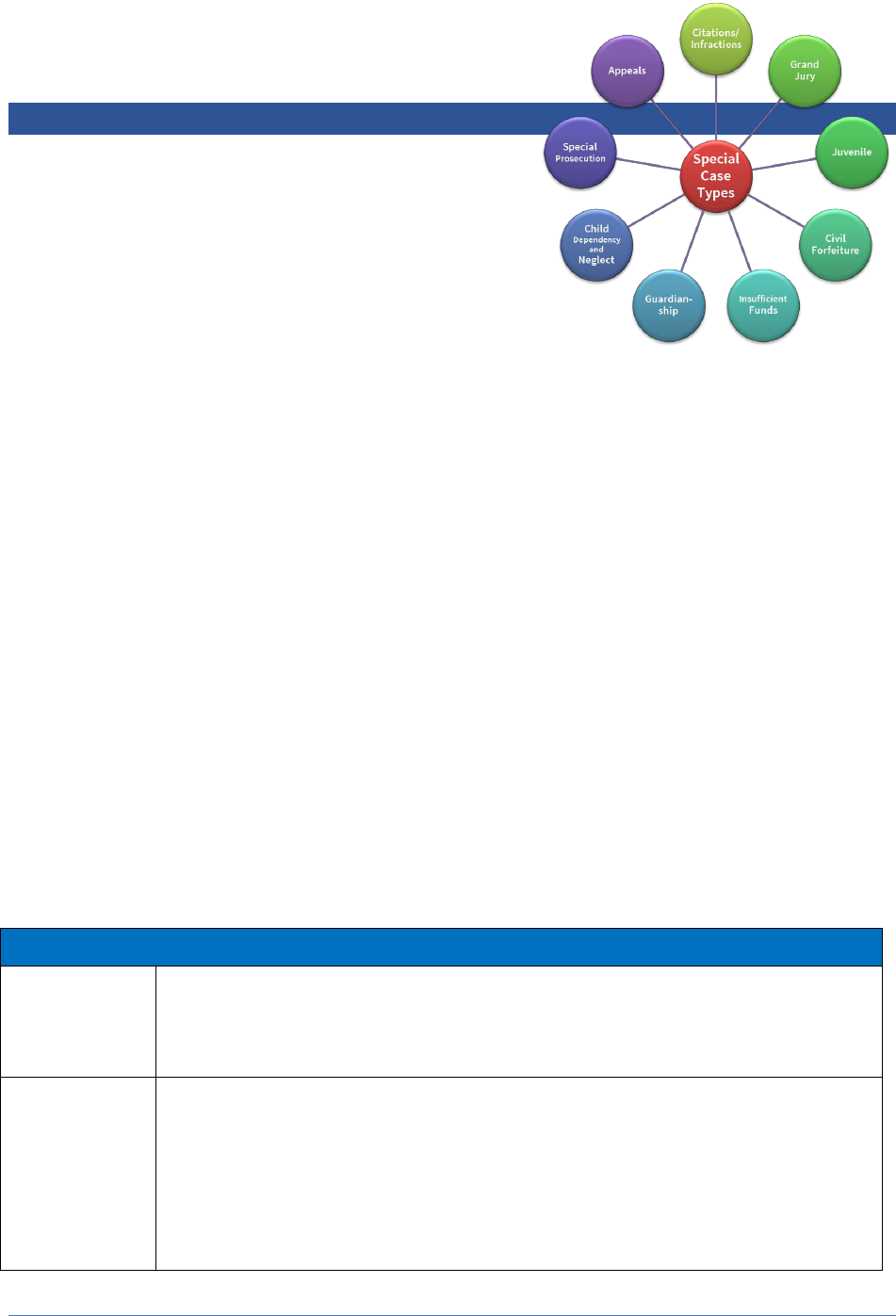
PCMS Functional Requirements 35
Section 4: Special Case Types
4a. Citation/Infraction
A citation is the allegation of a minor crime or infraction and a
notice to appear in court. It usually involves a minor infraction
(commonly traffic or local ordinance violations) that usually
results in a fine. A citation enables law enforcement to directly
charge the offender with a crime and does not require the
prosecutor to file the case. A prosecutor may be involved in
these cases when the person issued the citation does not plead
guilty and the case moves to trial.
Cases initiated by citation follow the same structure as other criminal cases, but the process is simplified.
Typically, cases initiated by citation where the defendant pleads not guilty are scheduled for trial and do not
require many of the pretrial activities associated with other criminal cases.
4b. Grand Jury
The grand jury is one of the ways that a prosecutor can establish probable cause and proceed with a criminal
prosecution. Grand juries are treated here as a special case because, while some states are required to use
the grand jury to determine probable cause for all serious/felony cases, it is optional or selectively used in
other states for this purpose. The grand jury process is often used in lieu of a preliminary hearing as the
means to establish probable cause that a crime was committed and that sufficient evidence exists indicating
that the defendant committed that crime.
Prosecutors need the same investigative information as when initiating a case by other means. As part of the
investigation, a prosecutor will review evidence gathered by investigators which, in turn, may be presented
to a grand jury.
After the prosecutor presents evidence, the grand jury either determines that probable cause exists—
commonly referred to as a “true bill”—or that probable cause does not exist—a “no true bill.” True bills are
filed with the court as an indictment to initiate the case in the general jurisdiction trial or court of similar
jurisdiction.
Business/Organizational
Process Activities
The prosecutor presents evidence and testimony to the grand jury to make a probable
cause determination and indict. The steps needed to perform the business functions
include case management and tracking functions that assist the prosecutor to present
the information to the grand jury for a true bill or no true bill.
Use Cases /
User Stories
To perform these functions, the user—
Collects and records information to uniquely identify a case, individuals involved
with a case, events leading up to charges associated with the case, and
supporting materials.
Assigns people to a case and/or enter new persons associated with a case.
Adds the reason for initiating the case.

PCMS Functional Requirements 36
Prepares the case for electronic filling based on court procedure, to file the case
with the court as soon as the grand jury indicts.
Provides prosecutors with information needed to present the case to the grand
jury.
Presents evidence and testimony to the grand jury seeking a true bill and
indictment. The tools to present evidence can be the same as for trial
presentation.
Statutory Duties /
Other Obligations
The prosecutor conducts grand jury proceedings. The prosecutor will explain the law to
the grand jury and present evidence gathered during the investigation. A grand jury has
broad power to see and hear almost anything they would like. Therefore, the prosecutor
may continue investigations based on the grand jury proceedings. If the defendant is
brought before the grand jury, the defendant is not entitled to present evidence or
testimony.
Applications
Application
Capabilities
In addition to the case initiation requirements, to support the grand jury
requirements the PCMS must—
Allow the user to manage juror information.
Allow the user to manage payments for juror service.
Allow the user to add/edit documents associated with the finding of a true bill or
no true bill indictment information.
Allow the user to add/edit charges.
Allow the user to add/edit probable cause and indictment information.
Allow the user to change a case status once the grand jury decision is complete.
Enable the user to electronically file the finding of the grand jury with the court.
Enable the user to electronically file the indictment when a true bill is returned.
Data Exchanges
Data exchanges for grant jury may include:
Incident reports
Indictments/grand jury information
Charge filings
Data Management
Data Needs
Data required for grand jury include elements from the following data groups:
Case
Person
Defendant detail
Charges
Event

PCMS Functional Requirements 37
4c. Juvenile
Most states require that juveniles be treated differently than adults when involved with the criminal justice
process. Prosecutors are often directed to consider the interests and needs of the juvenile with the intent to
rehabilitate or deter the juvenile from further criminal activity through counseling, restitution, juvenile
rehabilitation efforts, and other programs. In many jurisdictions, it is the prosecutor’s responsibility to decide
whether the juvenile case should be handled through the juvenile court, diverted to alternative resolution
mechanisms, or in the case of more serious offenses, transferred to the adult court.
Business/Organizational
Process Activities
Prosecutors receive an incident and/or arrest information from law enforcement
with a juvenile suspect.
The prosecutor reviews the incident/arrest information and charge
recommendations, then evaluates the circumstances of the case to determine if
the juvenile should proceed to adult court, juvenile court, or a diversion program.
The prosecutor tracks events, hearings, conferences, and diversion program
updates.
If the juvenile case is referred to adult court, the prosecutor follows the adult
criminal case processes.
If the juvenile court handles the juvenile case, the prosecutor:
o prepares a notice of delinquent acts.
o prepares for the adjudication hearing.
o tracks and participates in hearings, conferences, responds to motions,
manages victim and witnesses, and prepares evidence.
o presents the case at the adjudication hearing.
o strives to ensure that the juvenile disposition fits the delinquent act(s).
o tracks disposition and sentencing.
The prosecutor protects juvenile information by limiting access.
Use Cases /
User Stories
To perform these functions—
The user receives incident, arrest, or complaint information.
The user needs to —
o add and modify data and information for each case, participant, and event.
o convey information and notifications to participants.
o track and report on hearings, proceedings, and diversion program activities.
o review and file formal documents.
o track and report dispositions and sentences.
o ensure juvenile information and the juvenile are protected through auditing
of who accesses information, redaction of information, and access control.
The user reviews the information to determine the best course of action for a
juvenile: formal charging in juvenile court, referral to adult court, or referral to a
diversion program.
If the prosecutor decides to charge in juvenile court, the user will manage the
case through the standard process of events, with exceptions noted in this
section.

PCMS Functional Requirements 38
If the prosecutor decides to prosecute as an adult, the user will work the case
through the standard process of events.
If the prosecutor decides a diversion program is best, then the user tracks the
progress of the juvenile through the diversion program.
Statutory Duties /
Other Obligations
The juvenile processing must reflect the terminology and legal requirements of the
juvenile justice process. The prosecutor must protect juvenile records as required by law.
Prosecutors may refer juveniles to programs managed by other agencies. In juvenile
matters not diverted, the prosecutor assumes the traditional prosecution role. In most
jurisdictions, the same rules of evidence employed in adult criminal cases within that
jurisdiction apply to juvenile court cases. This approach promotes fairness to both the
victim and the community and promotes the rehabilitation of the juvenile.
Applications
Application
Capabilities
In order to support the business needs for juvenile proceedings, the PCMS must
follow the processes outlined in case management (Sections 1 to 3):
Case initiation
Pre-adjudication
Court events
Adjudication hearing tracking
Witness management
Victim management
Litigation support
Motion support
Disposition
Evidence management
Diversion program support
The PCMS must support the additional information security, privacy, and monitoring as
required for juvenile cases.
Data Exchanges
Additional juvenile data exchanges include:
Person and recommended actions for diversion programs
Diversion program progress report information
Data Management
Data Needs
Data required for juvenile proceedings include elements from the case initiation; the user
will need to enter relevant information that is available, validate information from data
exchanges, and match and update existing person information. Data required for juvenile
case initiation include elements from the following data groups:
Case
Person
Defendant detail (juvenile delinquent)
Events
Victim

PCMS Functional Requirements 39
Witness
Incident
Arrest
Booking
Evidence
Warrant
Additional data required for juvenile cases:
Additional Parties (Person)
Parents/guardians
Guardian ad litum
Presentation of case data and data outputs should reflect the special terminology
required by the juvenile justice process, such as identifying the juvenile as a delinquent,
not a defendant and not referencing adult penalties associated with specific charges.

PCMS Functional Requirements 40
4d. Civil Forfeiture
Civil forfeiture, sometimes referred to as civil asset forfeiture, is used in some jurisdictions to disrupt and
dismantle criminal enterprises, deprive criminals of the proceeds of illegal activity, deter crime, and restore
property to victims. The prosecutor’s role is to support the enforcement of statutes that permit the seizure of
property used in or obtained as a result of criminal activity.
x
Business/Organizational
Process Activities
Prosecutors are required to use asset forfeiture for the recovery of assets to victims of
crime, as permitted by law. The prosecutor may need to decide to return or relinquish the
forfeiture of property to an owner or interest holder other than the accused.
Use Cases /
User Stories
To perform these functions, the user—
Adds property information to the case file.
Receives a request for the property to be returned to the owner and decides
whether to return the property based on:
o establishing that the property was acquired legally and was not known by
the owner to be used in the activity that resulted in the forfeiture.
o understanding that the forfeiture causes hardship on the owner.
o the property will not be used in future criminal activity or benefit the one
whose conduct subjected the property to forfeiture.
Documents the return of the property.
Statutory Duties /
Other Obligations
The concept that a person should not be allowed to profit from criminal activity is the
underlying principle of forfeiture. It is the prosecutor’s responsibility to uphold their
respective statutory obligations and to serve the claimants by ensuring fair and equitable
distribution among the respective claimants. In addition to the restitution aspect, the
possibility of deterring further crimes is important.
Applications
Application
Capabilities
The civil forfeiture functions the PCMS must be able to perform are:
Manage and track seized property.
Produce receipts for the seized property.
Produce reports of seized property based on cases, defendants and victims.
Creates notifications for the strict filing deadlines.
Data Exchanges
Additional data exchanges may include:
Forfeiture information
Data Management
Data Needs
Data required for forfeiture include elements from the following data groups:
Person
Property

PCMS Functional Requirements 41
4e. Insufficient Funds
Insufficient funds are a common, typically minor, criminal activity. Prosecutors may wish to handle these
cases in a specialized way, which may include establishing a mechanism to handle restitution payments.
Business/Organizational
Process Activities
Provide procedures to merchants to prosecute an insufficient funds case that
includes educating merchants on gathering proper identification, requesting
payment, and completing an affidavit.
Collect information from the check as evidence.
Initiate a criminal case against the maker of the check, which may include a
request for a warrant or issuance of a summons or citation.
Handle minor offenders through a diversion program that emphasizes restitution.
Use Cases /
User Stories
To perform these functions—
The prosecutor receives a bad check complaint from a merchant and assists the
merchant with completing an affidavit and initiating a case against the maker of
the check.
The prosecutor requests an arrest warrant and issues a summons or citation to
the maker of the check.
Upon arrest, the prosecutor initiates a criminal case against the maker of the
check if repayment is not made.
Statutory Duties /
Other Obligations
Writing worthless checks is a criminal offense and prosecutors will work with merchants
to charge offenders.
Applications
Application
Capabilities
To support insufficient funds functions, the PCMS—
Must be able to produce a standard form of the affidavit for insufficient funds.
Should be able to request a warrant from the affidavit for insufficient funds.
Must be able to initiate a case based on information gathered to produce the
affidavit for insufficient funds.
Must be able to record and manage restitution payments to multiple victims.
Data Exchanges
Additional data exchanges for insufficient funds cases may include:
Summons
Arrest warrants
Data Management
Data Needs
Data required for insufficient funds include elements from the following data groups:
Person
Defendant details
Victim
Details concerning the check, the maker of the check, financial institution on
which the check was drawn, payee, date, amount, etc.
Notice and demand for payment information: merchant requested payment (oral
request information and written request information), dates, certified letter
details, partial payment.

PCMS Functional Requirements 42
4f. Guardianship
Guardianship refers to obtaining the legal means to make decisions for another person. A guardian is the
person appointed by the court to make decisions regarding someone else’s medical, mental health, and
safety needs.
Business/Organizational
Process Activities
The prosecutor may file requests for temporary guardianships under law at the request of a
public agency (e.g., Division of Child Welfare), when a person is in need of the immediate
appointment of a guardian, usually to consent to medical or mental health treatment.
Use Cases /
User Stories
To perform these functions, the user—
Enters person information for each party in the case.
Files for guardianship with the courts.
Tracks hearings related to the case; notifies parties required to attend the hearing,
and records the hearing results.
Statutory Duties /
Other Obligations
The prosecutor may represent the interests of the public in guardianship cases in
jurisdictions where the prosecutor or a public agency is the petitioner. The prosecutor
attends all hearings and sees these cases through to their completion.
Applications
Application
Capabilities
To support guardianship functions, the PCMS must—
Allow the user to enter case, person, and event information.
Provide the petition forms for the jurisdiction to file for guardianship.
Track and may provide notifications for events related to the case.
Data Exchanges
Data exchanges that support the agency needs include:
Hearing requests
Conference requests
Docketing/calendar information
Data Management
Data Needs
Data required for guardianship include elements from the following data groups:
Person
Events
Guardianship petition details (custody, abuse/neglect, estate)

PCMS Functional Requirements 43
4g. Child Dependency and Neglect
It is the role of the prosecutor to ensure that the child is afforded due process and other rights and that the
child is protected from further harm.
Business/Organizational
Process Activities
Referrals typically come from the county’s division of child protective services. The
prosecutor files a Petition for Protection, citing which statute under state law is the cause
for the filing – Neglect, Inadequate Care, Unborn Child, Abandonment, etc. Parties to the
case in addition to the child are typically a Guardian Ad Litem, mother, father, and any
members of law enforcement who may have been involved. The prosecutor attends all
hearings and sees these cases through to their completion.
Use Cases /
User Stories
To perform these functions, the user—
Enters person information for each party in the case.
Files a Petition for Protection with the courts.
Tracks hearings related to the case; notifies parties required to attend the
hearing, and records the hearing results.
Statutory Duties /
Other Obligations
The prosecutor represents the interests of the public and betterment of the child in child
protective service cases in jurisdictions where the prosecutor is the petitioner.
Applications
Application
Capabilities
For child dependency and neglect functions, the PCMS must—
Allow the user to enter case, person, and event information.
Provide the petition forms for the jurisdiction to file with the courts.
Track and provide notifications for all events related to the case.
Data Exchanges
Data exchanges for child dependency and neglect functions include:
Incident reports
Prior child welfare referral information
Hearing requests
Conference requests
Docketing/calendar information
Data Management
Data Needs
Data required for child dependency and neglect include elements from the following data
groups:
Person
Agency (Child Protective Service Agency)
Events (i.e., hearings)
Placement program information

PCMS Functional Requirements 44
4h. Special Prosecution
A special prosecutor is an attorney from outside of the agency’s jurisdiction assigned to handle a given case.
A prosecutor may elect to have a special prosecutor assigned, or the court may order that a special
prosecutor be assigned to handle the case.
Special prosecutors are used when a conflict exists with having the agency prosecute a given case. A special
prosecutor has the same powers as the prosecuting attorney of the jurisdiction, but the scope is limited to a
particular case or investigation. The PCMS must be able to track work and manage case activities for cases
assigned to outside prosecutors and track work and manage case activities for cases handled by the office on
behalf of another jurisdiction. To handle both scenarios, the PCMS must allow prosecutors from outside the
jurisdiction to be assigned to a case within the jurisdiction (in the event that a special prosecutor is needed
brought in), and the PCMS must allow for the entry of case information from outside the jurisdiction in the
event a prosecutor in the office is assigned as a special prosecutor.
Business/Organizational
Process Activities
The special prosecutor receives the assignment to work a case outside their
jurisdiction.
Special prosecutors discover and receive information using investigative
processes, law enforcement resources, and interviews with victims and witnesses.
Special prosecutors may review case information to make charging decisions.
Special prosecutors follow case tracking procedures to initiate a case, file charges,
and work the case through conclusion.
Use Cases /
User Stories
To perform these functions, the user—
Adds and modifies data and information for each case, participant, and event.
Provides information and notifications to participants.
Tracks and reports hearings and proceedings.
Produces or reviews and files documents.
Tracks and reports dispositions and sentences.
Statutory Duties /
Other Obligations
A special prosecutor has all the authority and performs all of the functions as the regular
prosecutor. The special prosecutor assumes the traditional prosecution role with respect to
prosecuting the case. The special prosecutor must follow the rules of evidence from within
the jurisdiction assigned.
The case should be included in the workload of the jurisdiction of the special prosecutor,
but statistically counted in the jurisdiction of the case.
Applications
Application
Capabilities
The PCMS needs to identify and manage all special prosecution cases and ensure
that enumerations—as well as contact, court, and law enforcement information that may
have originated from outside the agency’s jurisdiction—can be entered, tracked,
maintained, and reported. Special prosecution cases must be protected from unauthorized
disclosure, both within and outside of the prosecutor’s office.

PCMS Functional Requirements 45
The special prosecutor must be able to access and work with the PCMS from outside of the
prosecutor’s office.
The PCMS should follow all applicable standards for investigation and case tracking that
includes:
Investigations
Case initiation
Pre-adjudication
Court events
Adjudication hearing tracking
Witness management
Victim management
Litigation support
Motion support
Disposition
Evidence management
Diversion program support
The PCMS must provide information security, privacy, and monitoring, including case
locking internally within the office.
Data Exchanges
Additional data exchanges for special prosecutions include:
Complete case information from one PCMS to another if a case is turned over from
one jurisdiction to another
Data Management
Data Needs
Data elements required for special prosecution cases, in addition to the data groups from a
case within the prosecutor’s jurisdiction, include:
Special prosecutor identification, location, and role information.
Support staff information from outside the prosecutor’s office.
Case information from outside the jurisdiction.

PCMS Functional Requirements 46
4i. Appeals
An appeal is the legal process to review a court decision where an error has been perceived to have occurred.
Most commonly, appeals occur after a guilty verdict in a trial; however, appeals can occur at any time during
a criminal case. Those occurring prior to disposition are called interlocutory appeals.
Business/Organizational
Process Activities
When an appeal occurs, the prosecutor writes a brief for the appellate court that responds
to the issues raised in the appeal.
Prosecutor receives or files a notice of appeal.
Prosecutor prepares a written brief for the reviewing court.
Prosecutor prepares oral arguments.
Prosecutor presents case to reviewing court.
Use Cases /
User Stories
The following activities occur after an appeal has been filed. The user—
Reviews court records.
Reviews transcripts of court proceedings.
Reviews testimony and statements.
Reviews evidence.
Produces the brief.
Tracks and maintains court events related to the appeal.
Statutory Duties /
Other Obligations
Typically, initial appeals are filed with the next higher court in the same system. Appellate
courts review appeals from the trial courts. General jurisdiction/trial courts review appeals
from limited jurisdiction courts. The appealing party argues the legal basis for the appeal,
while the responding party argues against the issues raised in the appeal.
Applications
Application
Capabilities
For appeals functions, the PCMS must support—
Transferring the case from the trial prosecutor to the appellate prosecutor.
Identification and tracking of the venue of the appellate court.
Identification and tracking of the appellate prosecutor.
Developing appellate briefs.
Tracking and managing case activities through the appellate process.
Data Exchanges
Additional appellate-related data exchanges may include:
Complete case information from one PCMS to another if a case is turned over from
one jurisdiction to another.
Data Management
Data Needs
Data required for appeals include elements from the following data groups:
Case
Person
Defendant details
Court evidence and testimony
Appellate court information
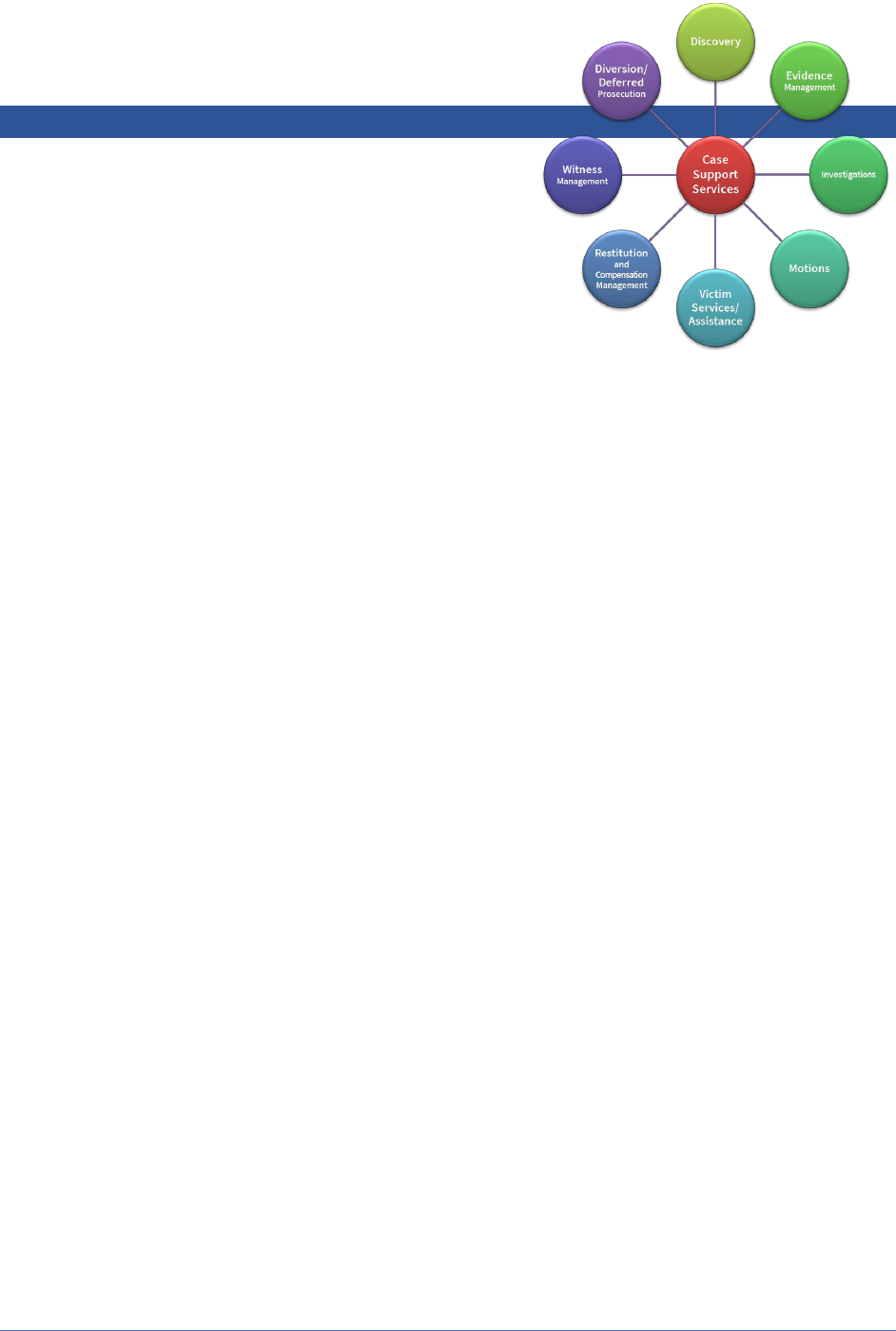
PCMS Functional Requirements 47
Section 5: Case Support and Services
5a. Discovery
Discovery is the legal process in which the parties to a case
disclose relevant information about the case to each other
and must include all case information that is not otherwise
“non-discoverable,” such as notes and work product.
Discovery must include exculpatory evidence. Discovery
involves the exchange of any information or evidence a
prosecutor intends to use against a defendant during trial.
Prosecutors provide the following types of discovery to the
defense:
• Crime scene evidence.
• Witness, law enforcement, and defendant statements.
Police reports: arrest, booking, toxicology, oral statements, etc.
Existing exculpatory evidence.
Results of physical testing or examination.
xi
Disclosure of witness deals, excessive use of force, untruthfulness, dishonesty, bias, or misconduct of
officers.
In a criminal proceeding, the prosecutor routinely provides discovery of case materials to the defense. This
exchange of information typically occurs prior to trial but may extend further in the process as evidence
surfaces. The discovery management process needs to identify and track the items that are provided as
discovery, and who and when the discovery process was performed. Not all materials contained in the
casefile are discoverable. Therefore, documents and other case materials need to be categorized as
discoverable or non-discoverable (e.g., case notes and other internal work product may not be discoverable).
In some states, costs associated with discovery may need to be collected and tracked. In some instances,
some materials may need to be redacted to protect privacy and privileged information.

PCMS Functional Requirements 48
Business/Organizational
Process Activities
As case information, evidence and other materials are received or produced, they
are categorized as discoverable or non-discoverable.
Case materials are digitized where practical.
Case materials are identified, labeled, and numbered sequentially (Bates Number).
Case materials are reviewed to meet privacy requirements.
Case materials are inventoried with the case in the PCMS and metadata is added
about the material.
Case materials are reviewed to determine whether exculpatory evidence is
contained in the materials.
A list of potential witnesses and their respective statements are generated by the
prosecutor handling the case.
If Giglio material is available about any witness intended to be called by the
prosecution, that information is included in the discovery.
The defense is notified of available discovery.
Items discovered are recorded, including recipient information and
acknowledgement.
Payment is received and recorded where required.
Use Cases /
User Stories
To perform these functions, the user—
Digitizes and scans physical documents and other printed material.
Uniquely identifies each item, captures metadata about the item, and categorizes it
using enumeration lists where practical.
May redact parts of images. Redaction should persist through all subsequent
processing and media.
Notifies the defendant and/or counsel of record of the availability of discovery using
information contained in the PCMS.
Maintains and updates counsel of record contact information and record multiple
notification methods, including mail, email, text, or phone.
Documents the date, time, and manner of each instance of notification or contact.
Documents that a request for discovery has been received and responded to.
Generates a digitized and hardcopies of discoverable materials.
Delivers discovery to the defense using an appropriate method and capabilities to
transfer large discovery files (e.g., via email, producing digitized media, or
providing a self-service web portal).
Generates Brady and Giglio disclosures.
Views all cases with pending discovery and navigates to any case with pending
discovery.

PCMS Functional Requirements 49
Views all discovery records related to a specific case, including payment records.
Presents to the court all records related to the materials identified as discoverable
and received by the defense to demonstrate that discovery has been fulfilled.
Statutory Duties /
Other Obligations
The prosecutor must fully and promptly comply with lawful discovery requests from
defense counsel.
The prosecutor must uniquely identify and label all discoverable items.
The prosecutor must uniquely number all document pages contained in the
discovery (Bates number).
The prosecutor must disclose the existence of evidence that is potential
contraband and make defense aware of it and provide an opportunity to inspect
upon request.
The prosecutor must disclose information related to Brady and Giglio requirements.
Applications
Application
Capabilities
To support discovery, the PCMS must—
Enable the user to inventory all items related to a case, record relevant descriptive
data about the items, and designate items as either discoverable or non-
discoverable.
Integrate discovery processing with the document management and evidence
management capabilities.
Enable the production of discovery materials where appropriate, such as digitized
evidence or digitized documents, and ensure that these materials cannot be
altered.
Track the distribution of discovery items—the system must track all discovery and
disclosure items exchanged by description, date/time, and entities that provided
the items, and entities that received the items.
Integrate with other case data, such as party information, to eliminate duplicate
data entry.
Allow each piece of discovery to be uniquely identified and numbered, if
appropriate (Bates numbering or sequential page numbering spanning multiple
documents).
Provide the capability to protect specific data elements from discovery.
Provide the capability to obscure or redact portions of images, videos and digitized
materials to protect identities.
Provide the ability to track and manage all discovery activities beginning with the
request or trigger for discovery through delivery of discovery. Triggers for discovery
must be configurable and user-defined.
Make metadata and other data elements associated with the discovery and
disclosure process configurable by the appropriate end user.
Allow the discloser of the Giglio list related to the case.
Make access to the discovery capabilities controllable by the appropriate end user.

PCMS Functional Requirements 50
If using a self-service web portal to support discovery, the PCMS should:
Ensure that discovery information for a case is accessible from the case, as well as
through an interface that focuses on performing discovery processing.
Provide a self-service web portal that allows authorized users (parties to the case)
access to discovery materials that can be downloaded or otherwise delivered to the
requesting party and to make payment for discovery if required.
Data Exchanges
Data exchanges include:
Discovery information
Evidence (audio, video, images, etc.)
When sharing discovery information, the exchange needs to include audit information (such
as description, date/time, and entities provided the evidence).
Data Management
Data Needs
Data required for discovery include elements from the following data groups:
Evidence
Additional data elements required by the capabilities:
Date received/Inventoried
Additional categorical/metadata information about the item
Bate number range (if applicable)
Person who performed the inventory work, and date/time the work was performed
Data related to discovery notification
Data related to discovery request
Person data group for person receiving the discovery item
Date, time, and method of delivery
Payment amount, date received, and materials discovered.

PCMS Functional Requirements 51
5b. Evidence Management
The prosecutor works with law enforcement and criminal justice agencies to manage evidence. There are
multiple scenarios when prosecutors must maintain control of evidence.
1. During investigation—similar to how a law enforcement agency handles evidence—all evidence and
property that the prosecutor collects and examines must be cataloged.
2. During trial, evidence becomes a part of the court case.
3. Evidence must be uniquely identified and inventoried within the PCMS or trial management software.
Business/Organizational
Process Activities
The prosecutor receives evidence from the initial investigation, during discovery,
or during follow-up investigation and in some cases during a trial.
The prosecutor must manage evidence of any type from any agency.
The prosecutor must ensure the evidence was not tampered with (chain-of-
custody) and is shared securely (encrypted).
User Cases/
User Stories
To perform these functions, the user—
Receives notice that evidence is in the custody of law enforcement and catalogs
it. Upon the receipt of evidence, the user enters unique identifiers, descriptions,
and categories, and who provided the evidence when.
Ensures that all evidence is marked and all records (including status) have not
been altered.
Shares documents, artifacts, and other material as evidence, physically and
electronically. When sharing evidence, the user records how it is shared
(electronically, physically, viewed, etc.), who received it, and when it was
provided.
Maintains a chain of custody and ensures the security of the evidence.
May redact pieces of evidence to secure information.
Categorizes evidence that is not admissible to prevent using it.
Edits the status of evidence when it is released to the rightful owner.
Tracks the release of evidence for investigation and court purposes.
Creates media and document copies of evidence at the request of the
investigator, defense attorney, court, etc.
Approves the destruction of evidence/property at the conclusion of a case.
Statutory Duties /
Other Obligations
The prosecutor must manage evidence in a secure, efficient, and reliable manner.
Applications
Application
Capabilities
To support evidence management, the PCMS must—
Add and relate evidence to a case.
Enable sharing of appropriate evidence with relevant parties during discovery and
maintain a complete chain of custody.

PCMS Functional Requirements 52
Audit any actions to ensure a chain of custody and authenticity.
Accommodate any privacy/redaction needs.
Track date/time received, received by whom, evidence type/description, and
provided to another entity (who/when).
Track evidence status, including ready for destruction, and provide an approval
for law enforcement to destroy the evidence.
Data Exchanges
Data exchanges include:
Evidence (audio, video, images, etc.)
Evidence analytical reports
Evidence tracking reports, including approval for destruction
When sharing evidence information, the exchange needs to include audit information
(such as description, date/time, and entities provided the evidence).
Data Management
Data Needs
Data required for evidence include elements from the following data groups:
Evidence
Evidence may also require a chain of custody log:
Item number
Date/time removed
Reason for removal
Removed by
Date analyzed
Analysis results
Analysis methods

PCMS Functional Requirements 53
5c. Investigations
Investigative capabilities fall into two categories within the prosecutor’s office. Investigators may participate
directly in the prosecution of a case by conducting witness interviews, managing evidence, and performing
other tasks at the direction of the prosecutor. In many jurisdictions, prosecutors also have the authority to
initiate investigations of criminal activity. In this latter role, prosecutor investigators may function like a law
enforcement agency as the original investigating agency. Examples of this may include the investigation of
crimes that span jurisdictional boundaries, such as Internet crimes and child exploitation.
Business/Organizational
Process Activities
Investigators within the prosecutor’s office collect and present evidence to the prosecutor.
Use Cases /
User Stories
To perform these functions, the user—
Collects and maintains evidence, documentation, and statements (see section 5b,
Evidence Management).
Prepares cases for prosecution by organizing evidence, statements, and other
materials related to the case.
Manages caseloads and investigators’ priorities, including:
o producing case summary reports.
o producing case aging reports.
o producing case pending reports.
o managing investigative notifications and alerts.
Produces warrant requests as needed.
Statutory Duties /
Other Obligations
The investigator is responsible for evidence and all other materials acquired during an
investigation that will be used in a criminal case. Business functions include capturing and
storing investigation data, requesting warrants, conducting interviews, producing investigative
reports, and initiating criminal charges or amending charges.
Applications
Application
Capabilities
To support investigative capabilities, the PCMS should—
Assign investigator(s) to the case.
Monitor/track the case investigative progress, and provide workflow alerts and
notifications to persons assigned the case.
Monitor/track evidence.
Create warrant requests.
Limit access to case information for security and privacy.
Data Exchanges
Additional data exchanges include:
Investigative reports
Search warrants
Data Management
Data Needs
Data required for investigations include elements from the following data groups:
Event
Incident
Evidence
Person
Witness
Victim
Defendant detail
Charge

PCMS Functional Requirements 54
5d. Motions
Motion practice is an important part of the pretrial, trial, and post-trial stages of a criminal case. A motion is
an application to the court made by the prosecutor or defense, requesting that the court decide certain
issues related to the case. A motion can affect the trial, courtroom location, defendants, evidence, or
testimony. Only judges decide the outcome of motions. Common motions include:
Motion to Dismiss A request by the defense to ask a judge to dismiss a specific count or the entire
case. The basis may be a lack of evidence, the alleged facts not amounting to a
crime, improper conduct by law enforcement or the prosecutor, delay or when the
destruction of evidence occurred.
Motion to Suppress A request to have the court exclude certain statements or physical evidence from
being introduced as evidence. For example, if police conducted a search without
probable cause (in violation of the Fourth Amendment), it may be possible to
suppress the evidence resulting from that search.
Motion for Change of Venue May be made for various reasons, including pretrial publicity. If the local news
has covered the case a great deal, it may be necessary to move the trial to
another venue to protect the defendant’s right to an impartial jury.
Motion to Vacate, Set Aside,
or Correct a Sentence Often successful for the purpose of correcting a clerical error in the sentence.
Motions in Limine The prosecution or defense may file a motion requesting the court to enter a
pretrial ruling on the admissibility of testimony, physical evidence, or evidence of
another crime. The proponent of the motion may be either seeking the admission
or exclusion of the evidence or testimony in the case.
Business/Organizational
Process Activities
Pretrial motions: To conserve the time of the jury, witnesses and other interested
parties, the prosecutor should attempt to have questions regarding: the charges,
incident and arrest, the admissibility of evidence or testimony, and venue resolved prior
to trial. In addition to saving court time, the pretrial rulings also allow for more efficient
pretrial preparation and, where permitted, the appeal of adverse rulings.
During the trial: Motions are usually made and resolved within the trial setting.
Post-trial motion: Motions may occur after the jury (or judge, in a bench trial) renders
its verdict. At the conclusion of a trial, a prosecutor may need to respond to or file
motions based on the outcome of the trial.
Use Cases /
User Stories
To perform these functions, the user—
Searches, views, and prints information for each motion.
Creates motion documents from templates.
Views and updates attorney and staff calendars for hearings.
Reviews the court schedules to update attorney and staff calendars.
Reviews the evidence, facts, and other artifacts related to the case to prepare
motions.

PCMS Functional Requirements 55
Statutory Duties /
Other Obligations
The rules for motions include:
The admissibility of evidence, exhibits, demonstrations, or argument is left to
the court for determination.
The history of all related activities should be viewable for a given motion.
Applications
Application
Capabilities
To support motions, the PCMS—
Must track and manage all facts related to the case.
Must track the status of the motion workflow.
Must track the schedule for each motion hearing per case, per participant.
Should track the history of each motion per case, including results of the event.
Should provide alerts and notifications to ensure that the users understand who
is assigned to work on the motion, who is required to attend each hearing, what
artifacts they need for each hearing, and when and where each hearing is to
take place. This includes alerts regarding:
o hearing status (pending, complete, overdue)
o logging receipt of documents
o meetings
o correspondence
o work products
o tasks
o assignments
o deadline
o contacts
Data Exchanges
Data exchanges include documents and document metadata.
Data Management
Data Needs
Data required for motions include elements from the following data groups:
Person
Case
Event

PCMS Functional Requirements 56
5e. Victim Services/Assistance
The prosecutor is responsible for preparing victims to participate in the adjudication process, and informing
victims about services available to help them deal with their victimization. The prosecutor must convey
information to victims (notifications), orient victims to the criminal justice process, provide victim assistance,
inform victims about and arrange for compensation, and provide victim protection (including physical
protection, protecting the identity of certain victims, and protecting personally identifiable information (PII)).
Business/Organizational
Process Activities
The activities associated with victim services and assistance include the following.
The prosecutor or victim advocate—
Explains the various stages of a criminal case to the victim, including potential
implications.
Explains the limitations placed on the prosecutor in terms of duties to the victim.
Works with victims to comply with victim rights and notify victims of their rights.
Works with victims to receive forensic interviews, medical exams, and sexual
maturity assessments.
Track victim subscriptions to notifications—what notifications each victim opts to
receive.
Notifies victims of case progress, acceptance or rejection of charges, return of
indictment, or filing of charges.
Notifies victims of pretrial release of defendant.
Notifies victims of post-conviction events.
Makes the victim aware of automated notification systems that inform the victim
of case events and any custody changes of a defendant.
Informs the police department with jurisdiction over the victim’s address of any
special conditions of bail and no contact orders.
Advises the victim of potential remedies to ensure safety, including stay away
orders or orders of protection, or no contact orders.
Notifies victims of hearing and trial dates and results.
Works with the victims to prepare for grand jury or in-court testimony.
Notifies victims of sentencing dates and results.
Tracks and monitors victim/defendant interactions.
May notify victims of any proceeding within the knowledge of the prosecutor
which does or may result in the defendant no longer being incarcerated,
including appellate reversal, parole, release, and escape.
Notifies victims of any other event within the knowledge of the prosecutor that
may place the victim at risk.
Assists victims in applying for fees and/or compensation and restitution.

PCMS Functional Requirements 57
May assist the victim with travel arraignments for events that require the victim’s
presence.
Works with other law enforcement to protect victims’ right to privacy, including
names, addresses, medical records through redaction, and the use of
pseudonyms.
Informs victims of programs available to protect victims of crime from intimidation
and harm arising from the victim’s cooperation.
Explains the sentencing parameters a defendant may face based on the
charges.
User Cases/
User Stories
To perform these functions, the user—
Adds victim information and relates victims to case(s), charge(s) and offender(s).
Adds victim statements.
Adds victim subscriptions for notifications.
Relates victims to case events for notifications and subpoenas.
Receives and enters information related to forensic interviews, medical exams,
and sexual maturity assessments.
Uses information in the system to convey information and notifications to victims
via letter, email, phone, and in person.
Tracks victim referrals.
May manage victim property that may be evidence—track where the property is
located, who is in possession of the property, and when it was seen or
transferred.
May track victims’ application for fees and/or compensation and restitution.
May track victims’ transportation and lodging needs and expenses.
Protects victim personal information throughout case progress.
Statutory Duties /
Other Obligations
The business rules for victim services and assistance include:
The prosecutor may have legal obligations to provide services to victims,
including notification of critical events, the opportunity to participate in trial and
disposition strategy, the ability to address the court if a defendant is convicted,
the ability to receive compensation and restitution, and receive other support
services.
Applications
Application
Capabilities
Victim services and assistance is ongoing throughout the adjudication process; as
such, the PCMS must integrate the victim services with all aspects of the case.
To support victim services and assistance, the PCMS—
Must allow users to add and edit victim information—victims should be added to
the person data group and linked to case(s), events, and defendants.
Should allow the automated entry of victim information from the law enforcement
system via information exchanges.
o The PCMS should allow the user to accept/reject information.

PCMS Functional Requirements 58
Should allow the automated entry of victim information from other entities for
forensic interviews, medical exams, and sexual maturity assessments.
o The PCMS should allow the user to accept/reject information.
Must allow the user to automatically search the PCMS for a pre-existing person
record that can be used to identify and link together multiple cases related to the
same individual.
Must track case information and allow the user to provide notifications to victims.
o The PCMS should allow users to select what notifications each victim
wishes to receive.
o The PCMS should generate victim letters and electronic notifications.
Must allow the user to utilize redaction and/or pseudonyms to protect victim
information from being released.
Must track services provided to victims—either from the prosecutor or through
referral programs.
Must track victims’ property.
Must allow access to victim and case information as required by the victim
advocates.
Must track expenses related to victim travel and lodging.
Data Exchanges
Data exchanges include:
Incident reports
Forensic reports
Assessments
Victim notifications
Docketing/calendar information
Data Management
Data Needs
Data required for victim services/assistance include elements from the following data
groups:
Case
Victim
Property
Events
Evidence
Disposition
Additional data elements may include:
Referral Tracking
o program/agency/advocate name and identification
o date referred
o description

PCMS Functional Requirements 59
5f. Restitution and Compensation Management
Restitution is intended to restore the victim’s loss. Compensation is a separate mechanism to provide
some payment for loss resulting from being victimized. Compensation is not paid directly by the
defendant to the victim, and the victim may be eligible for compensation whether or not the defendant
is convicted. The prosecutor may be responsible for managing either or both restitution and
compensation.
xii
Business/Organizational
Process Activities
The prosecutor or victim advocate may be responsible for determining the eligibility of a
victim to receive compensation, and for tracking restitution and compensation payment and
collection activities, including, but not limited to, the following:
The prosecutor gathers and documents information needed for the restitution
request.
The prosecutor creates the restitution request.
The prosecutor notifies victims of restitution orders.
The prosecutor collects and disseminates payments.
The prosecutor tracks obligations, amounts paid, and amounts due.
The prosecutor notifies defendants of overdue payments.
Use Cases /
User Stories
To perform these functions, the user—
Collects and stores restitution request information.
Determines and stores information related to compensation.
Creates the restitution request.
Receives the restitution order.
Collects payments.
Disseminates payments.
Tracks and reports financial statements with the amount paid and amount
remaining due, along with the terms of the payment plan.
Establishes and manages victim expectations and obligations with a payment due
date report.
Statutory Duties /
Other Obligations
The prosecutor should work with courts to establish restitution and compensation for victims
and ensure payments are collected and disseminated according to the restitution order
consistent with state law.
Applications
Application
Capabilities
To support restitution and compensation functions, the PCMS—
Must allow users to add and edit victim and defendant information.
Must allow the users to gather and document restitution materials.
Must assist the user with restitution calculations according to local laws.
Must create the restitution request and allow the user to electronically file the
request with the courts.

PCMS Functional Requirements 60
Should allow the automated entry of information from the court case management
system via information exchanges.
o The PCMS should allow the user to accept/reject information.
Should automatically track any obligation or payment plan.
Should generate restitution notifications and both information reports and letters
related to the obligation and payment plan.
Should provide a due date calculator to establish and manage any victim
expectation or defendant obligation.
Should allow users to query accounts.
Should store and use case-specific data and contact history, and keep track of
additional contacts and activity notes.
Should post payment, handle overpayments, adjustments, reversals, and NSF
checks.
Should monitor payment history, allocate funds.
Should allow for multiple victims per defendant.
Should track and manage multiple payment plans per case/debtor.
Data Exchanges
Data exchanges include:
Fine/fee/restitution orders
Data Management
Data Needs
Data required for restitution include elements from the following data groups:
Person
Victim
Property
Financial Obligations:
Accounting of payments – by specific case, victim, or defendant
Payment schedule
Payment history

PCMS Functional Requirements 61
5g. Witness Management
The prosecutor is responsible for preparing witnesses to testify in a case and manage all aspects of their
attendance and compensation, if applicable. The prosecutor’s office is responsible for keeping witnesses
informed of all court events where the witnesses may be required to attend. The prosecutor is responsible
for scheduling witness appearances at these events. They also should advise witnesses of their role in the
criminal justice process, and provide assistance in applying for witness fees, employer intervention,
transportation and lodging, and witness protection.
Business/Organizational
Process Activities
The prosecutor should communicate with and prepare witnesses for their role in the case
and provide assistance to witnesses as needed, including, but not limited to, the
following:
The prosecutor notifies witnesses of case progress to the extent the progress
affects the witness and the witness needs to be available.
The prosecutor prepares witnesses to give testimony.
The prosecutor notifies witnesses when the defendant is no longer being
incarcerated, including appellate reversal, parole, release, and escape.
The prosecutor works with the officer to ensure they are available.
The prosecutor notifies witnesses of any other event that may place the witness
at risk.
The prosecutor produces a subpoena requiring the witness be present at a
proceeding, hearing, or trial.
The prosecutor provides the defense any exculpatory information about
individuals in the case following Brady and Giglio policies.
The prosecutor assists the witnesses’ application for fees and/or compensation.
The prosecutor tracks witness transportation and lodging needs and expenses.
Use Cases /
User Stories
To perform these functions, the user—
Collects and stores witness contact information.
Collects witness statements and testimony.
Collects and stores Brady and Giglio information for individuals.
Informs witnesses of case and defendant status, as well as dates and times the
witnesses need to appear for hearings, pretrial conferences, testimony, and
other events/activities.
Utilizes officer tracking so that subpoenas can be served.
Conveys information and notifications to witnesses via subpoena, letter, email,
phone, and in person.
Assists witnesses in applying for fees and/or compensation.
May assist the witness with travel arraignments for events that require the
witness be present and track and report compensation for expenses.
Works with other law enforcement to investigate and prosecute any type of
witness intimidation, harassment, coercion, or retaliation, including any such
conduct or threatened conduct against family members or friends.
Works with other law enforcement to protect witnesses.

PCMS Functional Requirements 62
Statutory Duties /
Other Obligations
The prosecutor should:
Keep witnesses informed of all pretrial hearings where the witnesses are
required to attend.
Keep witnesses informed of trial dates and the scheduling of that witness’s
appearance.
Assist the witness to recover costs and other compensation (expert witness
fees).
Protect the witness from the possibility of intimidation and harm arising from a
witness’s cooperation with law enforcement.
The prosecutor needs to provide any exculpatory information about individuals in the
case to the defense.
Applications
Application
Capabilities
To support witness management, the PCMS—
Must allow users to add and edit witness information—a witness should be
added to the PCMS once and linked to case(s), events and defendants.
Must allow users to enter or locate Brady and Giglio information about
individuals in the case.
Should allow the automated entry of witness information from the law
enforcement system via information exchanges, including officer schedules.
o The PCMS should allow the user to accept/reject information.
Must allow the user to automatically search the PCMS for a pre-existing person
record that can be used to identify and link together multiple cases related to the
same individual.
Should generate witness notifications: The PCMS needs to generate both
information letters and subpoenas to witnesses required for trial. The subpoenas
should contain all of the relevant information both for the witness and the other
evidence to be presented at trial, including agency case number, arrest tracking
number, property tag numbers, and any other identifying information for the
evidence that a witness must bring to trial.
Should track compensation for expert witnesses—who, date/time, amounts
(paid/due), and case associations.
Should track applications for compensation of expenses related to travel and
lodging.
Data Exchanges
Data exchanges include:
Incident reports
Witness notifications
Subpoenas
Docketing/calendar information
Data Management
Data Needs
Data required for witness management includes elements from these data groups:
Person
Event
Evidence
Disposition
Witness

PCMS Functional Requirements 63
5h. Diversion/Deferred Prosecution
Diversion involves guiding criminal defendants and potential defendants into programs that may not result in
a criminal conviction. The purposes of diversion programs are to improve offender outcomes by reducing
recidivism and reducing the workload of the judicial system.
Business/Organizational
Process Activities
The prosecutor should obtain information from appropriate agencies to decide if a
diversion program is best for the defendant, victim, and community. The prosecutor must
have the criminal history of the potential diversion candidate to determine eligibility in the
program.
The prosecutor should track diversion program effectiveness.
Use Cases /
User Stories
To perform these functions, the user—
Gathers information related to the case, defendant, diversion programs, and
charges.
Tracks statistics related to diversion programs.
Tracks the defendant’s progress within the program.
Statutory Duties /
Other Obligations
Prosecutors may have the statutory authority to provide alternatives to prosecution
through the use of various forms of diversion.
Applications
Application
Capabilities
The PCMS needs to collect and report all relevant investigative information, personal
data, case records, and criminal history information necessary to make diversion
decisions about individuals.
The PCMS should provide a tracking mechanism for each defendant in a diversion
program. The diversion tracking is similar to event tracking, but also requires the PCMS
to track:
A signed agreement or court record with the diversion requirements and
provisions for the defendant.
A signed waiver of speedy trial.
The diversion program activities to track terms and conditions, compliance, etc.
Data Exchanges
Additional data exchanges include:
Interim dispositions (e.g., assignment to pretrial diversion program, deferred
prosecution, etc.)
Diversion program information
Data Management
Data Needs
Data required for diversion include elements from the following data groups:
Charge
Defendant details
Additional data elements may include:
Any special characteristics or difficulties of the offender which often includes
results from a validated risk/needs assessment instrument.

PCMS Functional Requirements 64
Whether the defendant is a first-time offender.
History that the defendant will cooperate with and benefit from the diversion
program.
Recommendations from the arresting agency.
Victim statements.
Diversion statistics—how successful diversion programs are with respect to
similarly situated defendants.
Diversion program details include:
o diversion program name/description
o the reasons for diversion
o referral dates
o contact information
o completion certificate and date
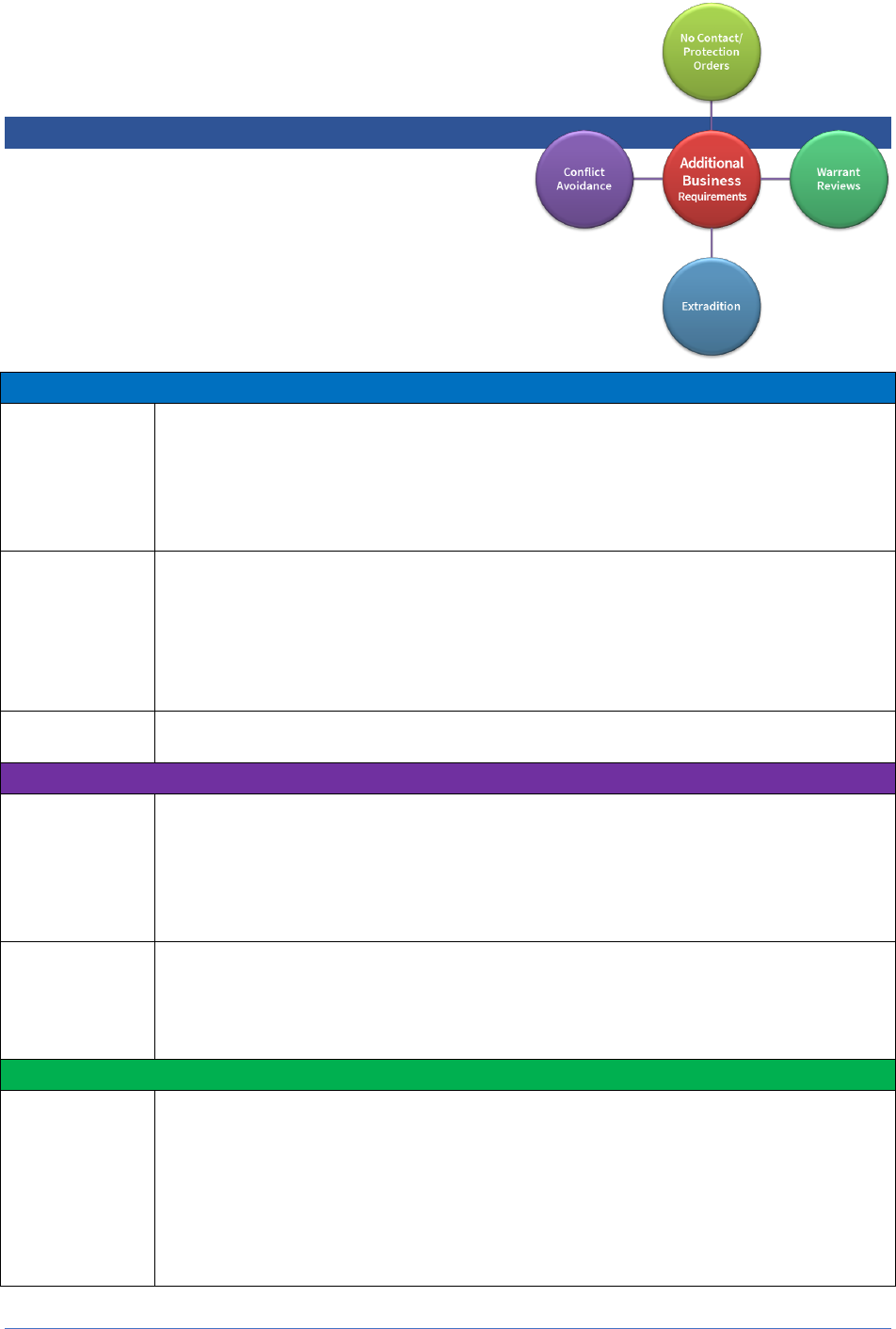
PCMS Functional Requirements 65
Section 6. Additional Business Requirements
6a. No Contact and Protection Orders
The prosecutor should monitor any protection order to help
ensure victim safety. Prosecutors seek and maintain no contact
orders in the prosecution of domestic violence cases to protect
the victim and their family. For purposes of this document, no
contact orders are part of a criminal case where a protection
order is a civil proceeding.
Business/Organizational
Process Activities
Prosecutors, investigators, or victim advocates interview victims to determine the
need for a no contact order.
If required, prosecutors petition the court to issue a no contact order.
Where no contact orders are mandatory, the prosecutor ensures that the protection
order is issued.
Use Cases /
User Stories
To perform these functions—
The user collects victim and defendant information, including any standing
protection or no contact orders.
Victim advocates or prosecutors monitor communications and contact between the
defendant and victim and if a violation occurs, the prosecutor may add charges,
seek an arrest warrant, or request bond revocation.
Statutory Duties /
Other Obligations
Prosecutors are responsible for victim safety. Therefore, prosecutors and victim advocates
should work with victims to identify and address risk of harm.
Applications
Application
Capabilities
To support no contact and protection order capabilities, the PCMS must allow users to—
Add/modify victim information.
Add/modify defendant information.
Create the documents to file a no contact order.
Track protection and no contact orders.
Data Exchanges
Data exchanges include:
Incident reports
Hearing requests
Motions/orders from hearings
Data Management
Data Needs
Data required for no contact and protection orders include elements from the following data
groups:
Person
Protection order information
o date
o conditions
o description
o parties

PCMS Functional Requirements 66
6b. Warrant Reviews
The prosecutor’s office should develop and maintain a system for providing law enforcement with the
opportunity for a prompt legal review of application and affidavit for search and arrest warrants before they
are submitted to a judicial officer for review and issuance.
Business/Organizational
Process Activities
Prosecutor needs to complete warrant reviews in a timely manner, as most
warrants are time-sensitive.
Prosecutor needs to track any changes to the application and affidavit to help train
law enforcement on the technical requirements to increase the likelihood that the
warrant will be approved by the court and hold up to defense challenges.
Use Cases /
User Stories
To perform these functions, the user—
Receives an application and affidavit for a warrant from law enforcement to review.
Edits and may approve the application and affidavit and returns to law
enforcement.
Tracks warrant status.
Includes the warrant in the evidence and discovery for the case, after the warrant is
served.
Relates warrant information to a case, person, and events.
Needs to retrieve, edit, and save application and affidavit for warrant information
within the case file.
Statutory Duties /
Other Obligations
The prosecutor reviews the requirements for issuance of arrest, search, and surveillance
warrants in order to provide legal assistance to law enforcement to help ensure that the
warrants will be authorized by the court and survive motions to suppress.
Applications
Application
Capabilities
To support warrant review, the PCMS should—
Allow users to add and edit warrant information.
Relate warrant information to cases, persons, and events.
Assign reviewers to the warrant.
Assign a time box to each warrant.
Monitor/track the progress, and provide workflow alerts and notifications to persons
assigned the warrant review.
Track any suggested edits to the application and affidavit for the warrant.
Data Exchanges
Data exchanges include:
Information warrants
Arrest warrants
Search warrants

PCMS Functional Requirements 67
Data Management
Data Needs
Data required for warrant reviews include elements from the following data groups:
Person
Agency
Additional warrant data elements include:
o probable cause statement
o location to be searched if a search warrant
o date/time (when to serve warrant)
o crime identification
o evidence sought (search warrant)

PCMS Functional Requirements 68
6c. Extradition
Extradition is legal process used to return a defendant who has fled to another state, tribal nation, or country
to gain custody of the defendant in order to proceed with criminal prosecution. Federal law governs
extradition
xiii
from one state to another and governs how that individual is returned to the state having
jurisdiction of the crime. Extradition falls under the authority of the governor of a state and the PCMS must
support the activities performed by the prosecutor to secure extradition.
International extradition is governed by treaties between nations; however, the process for extradition
between nations is similar to that between states.
Business/Organizational
Process Activities
Prosecutors prepare and review extradition documents required by the governor to
complete the extradition process. Prosecutors monitor the process and may arrange for the
transport of the offender back to the appropriate jurisdiction. The principal requirements for
extradition are as follows:
The offender has been arrested on a valid warrant—an order from the Executive
Authority of the demanding state.
A judicial hearing is held in the state having custody of the fugitive.
A waiver of extradition by the fugitive or a judicial finding that the extradition order
conforms to all legal requirements.
Custody is to be taken by the demanding state of the fugitive within 30 days.
xiv
If the demanding state does not take custody within 30 days, the fugitive may be
discharged.
Use Cases /
User Stories
Requesting extradition:
If the person needs to be located, the prosecutor works with law enforcement to
issue an interstate warrant (or Interpol red notice for international requests).
The prosecutor prepares an extradition order.
The prosecutor sends the extradition documents to the governor.
The prosecutor monitors the extradition process and, upon execution of the
extradition order or governor’s warrant, arranges for fugitive transportation.
Receiving an extradition request:
The prosecutor receives an extradition order/governor’s warrant from the
appropriate authority.
The prosecutor informs the fugitive of the extradition order, including the underlying
criminal charge and that the fugitive has a right to legal counsel.
If the fugitive wishes to contest extradition through a writ of habeas corpus, the
fugitive can petition the court for a hearing to contest the order. The prosecutor
argues before the court to determine the legality of the order.

PCMS Functional Requirements 69
Statutory Duties /
Other Obligations
A state court analyzes four issues when determining whether to extradite:
Whether the extradition request documents are in order.
Whether the person is charged with a crime in the requesting state.
Whether the person named in the extradition request is the person charged with
the crime.
Whether the person is a fugitive from the requesting state.
Applications
Application
Capabilities
To support the extradition functions, the PCMS—
Must create the required extradition documentation that may include a charging
document or affidavit.
Must manage workload and calendars for extraditions (30-day timeframes).
Must manage hearing information for extraditions.
Should track costs of extraditions.
Data Exchanges
Data exchanges may include:
Relevant case information for the governor’s office
Data Management
Data Needs
Data required for extradition include elements from the following data groups:
Agency
Court
Person
Defendant details
Incident
Custodial status
Criminal history
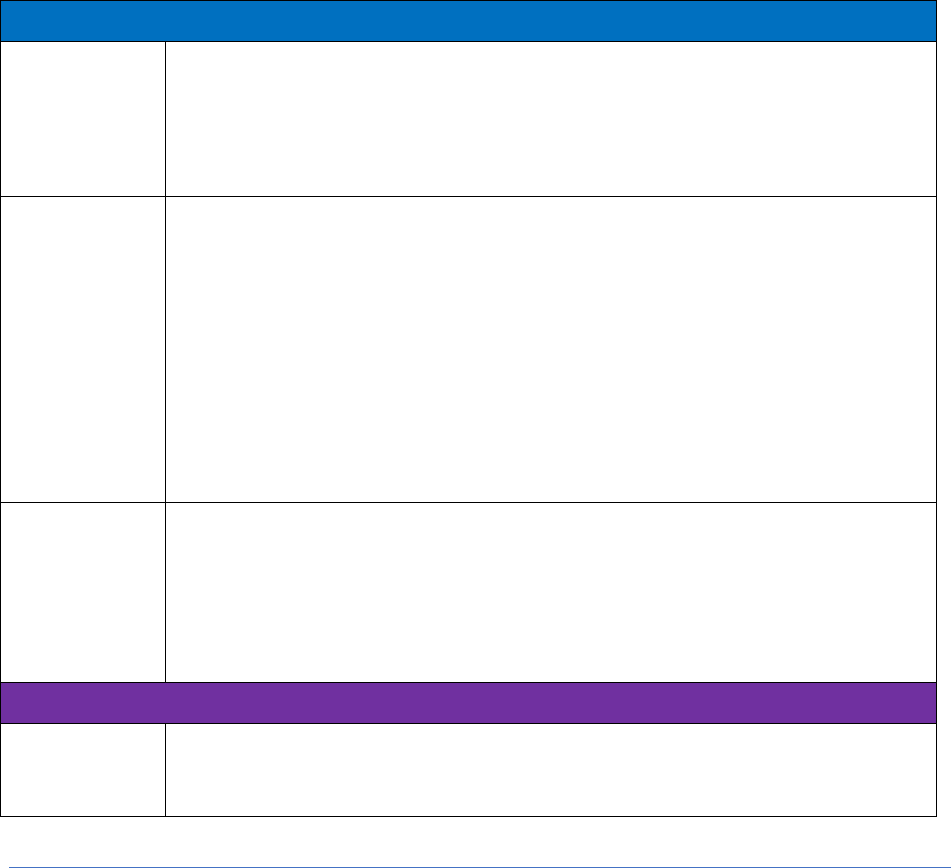
PCMS Functional Requirements 70
6d. Conflict Avoidance
Conflicts of interest occur when a prosecutor is related to a defendant, has a financial relationship with the
defendant, has a relationship with the judge the case is assigned to, has a relationship with the attorney
representing the defendant, has a relationship with a victim or witness in a case, has a relationship with one
of the government entities involved in the case, represented the defendant in a previous case, or if the
prosecutor cannot administer the law in an objective manner.
Other types of conflicts may arise with other individuals associated with the case. The Brady doctrine
xv
is a
pretrial discovery rule that requires that the prosecution turn over all exculpatory evidence to
the defendant in a criminal case. Additionally, disclosure of agreements with witness, police dishonesty, and
access to all information related to the investigation is required under the Giglio ruling. The Brady and Giglio
decisions require investigators to inform prosecutors of information that casts substantial doubt upon the
accuracy of an officer’s testimony or would allow the defense to question the veracity of the witness. The
International Association of Chief of Police (IACP) Model Policy on Brady Disclosure Requirements lists
examples of material, including "Information that casts doubt on the credibility or accuracy of a witness or
evidence” and “An officer's excessive use of force, untruthfulness, dishonesty, bias, or misconduct in
conjunction with his/her service as a law enforcement officer.”
xvi
Business/Organizational
Process Activities
Each prosecutor’s office should establish procedures for handling actual, potential, or
perceived conflicts of interest. These procedures should include, but are not limited to:
Searching case files for the existence of any conflicts.
Methods to accurately document the manner in which conflicts were handled to
ensure public trust and confidence in the prosecutor’s office.
Use Cases /
User Stories
To perform these functions, the user—
Collects detailed information about participants in each case.
Performs conflict checks across cases by searching case files for common
participants.
Should cross-reference a Giglio list—a list of potential witnesses and other
parties with credibility issues—with the witness list and generate the appropriate
disclosure.
Discloses exculpatory/conflict information to the defense.
If a conflict is found, then the prosecutor may request special counsel.
Statutory Duties /
Other Obligations
The prosecutor should decline to participate in a case where he/she has a conflict of
interest.
The prosecutor is responsible for following Brady v. Maryland (1963), which requires the
prosecutor disclose exculpatory evidence, and Giglio v. United States (1972), which
requires the prosecutor provide the defense with any information germane to the
credibility of the prosecutor’s witnesses.
Applications
Application
Capabilities
In order to support the conflict of interest business process, the PCMS—
Must search persons at the time participants are added to a case and provide
reports of potential conflicts

PCMS Functional Requirements 71
Must allow the user to enter detailed information related to each participant in a
case.
Must allow the user to quickly and easily perform conflict checks for each person
added to a case.
Should cross-reference a Giglio list so any file a prosecutor is assigned will
identify and generate an appropriate disclosure when the witness name is
entered into the witness list for the case.
Should provide a report of any potential conflicts, including Giglio disclosures.
Data Exchanges
Data exchanges include:
Docketing/calendar information
Case participant information
Investigative and support personnel previously known to have conflicts.
Data Management
Data Needs
Data required for conflict avoidance include elements from the following data groups:
Person
Case
Event
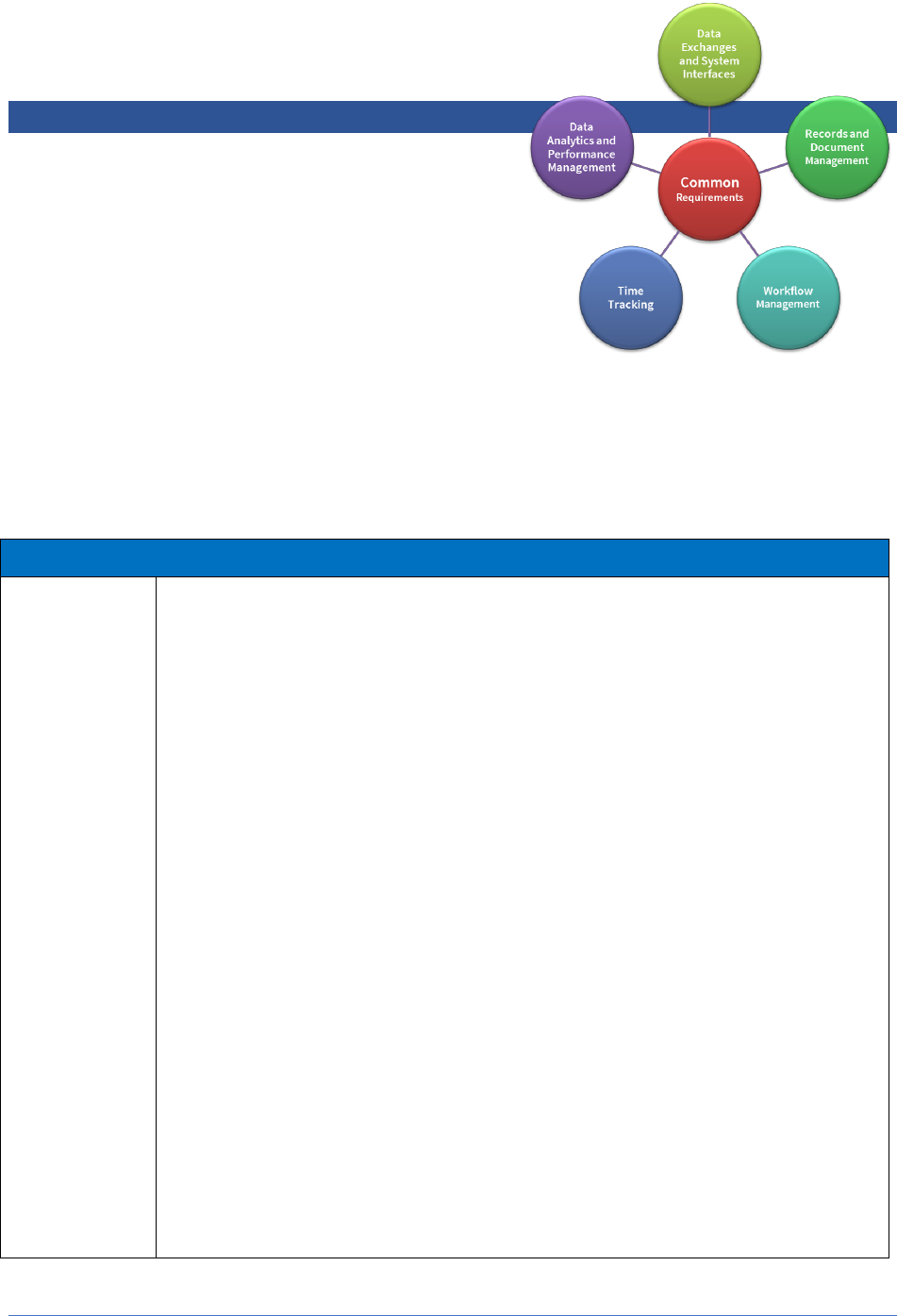
PCMS Functional Requirements 72
Section 7: Common Requirements
7a. Data Exchanges and System Interfaces
The PCMS requires functionality to exchange data with
external sources to:
1) increase efficiency by reducing the need for
redundant data entry
2) decrease the likelihood of human data entry errors
3) use data from the authoritative source, and
4) report data as required by law.
Business needs will determine the exact nature of the information exchanges and should include exchanges
with law enforcement and the courts. All information exchanges should be automated whenever possible,
and should comply with national standards, such as the Global Reference Architecture (GRA) and National
Information Exchange Model (NIEM), whenever possible.
Business/Organizational
Process Activities
The activities associated with the Data Exchange/System Interface component include:
The prosecutor receives daily arrest/booking reports from law enforcement
agencies and makes prosecution determinations.
o If the prosecutor decides to prosecute, a new case is generated and law
enforcement charging and related information is transferred to the
appropriate fields within the PCMS.
o If the prosecutor declines to prosecute, the arrest and booking information,
along with the declination, is transmitted to the state criminal history
repository and referring law enforcement agency.
The user requests incident and other investigative reports from law enforcement
agencies. The electronic files are sent to the user, and they are attached to the
case within the PCMS.
The user requests reports from forensic interviews, medical exams, and sexual
maturity assessments.
The user electronically files charging documents with the courts.
The user files amended charges with the courts.
The user submits requests for hearings/motions/pretrial conferences to the
courts.
The user receives case information from the courts (scheduled events, changes
in representation, changes in case assignment, dispositions and sentences, etc.)
The user submits information regarding defendant participation in a pretrial
diversion program to the state criminal history repository.
The user receives electronic information, including criminal histories, warrants,
protection orders, and sex offender registration status, from the state repository.

PCMS Functional Requirements 73
The user reports appropriate firearms disqualifier information to the state or
national firearms background check program.
The user reports certain criminal convictions to various State agencies that
license professionals.
The user provides evidence tracking reports and approval to destroy evidence to
law enforcement.
Use Cases /
User Stories
The user may receive the following data electronically:
Incident and arrest reports from law enforcement agencies.
Investigative information from law enforcement agencies.
Information from forensic interviews, medical exams, and sexual maturity
assessments.
Booking and arrest information from jail or detention facilities (ABIS).
Citations from law enforcement.
Court filings.
Court case events (e.g., hearings, motions, trials).
Judgment and sentencing information.
Warrant/wanted person information.
Protection order information.
Sex offender registry information.
The user sends declinations to prosecute to the state criminal history repository and/or
referring law enforcement agency.
The user sends the following information to the referring law enforcement agency and
the state criminal history repository:
Charges filed against a defendant
Disposition outcomes that are the responsibility of the prosecutor, such as case
declinations, diversion referrals, and diversion completions.
The user sends the following information to the referring law enforcement agency:
Evidence tracking and destruction notices.
The user sends the following to the court:
Criminal charges/filing documents.
Requests for hearings/motions/pretrial conferences.
Other eFiling functions supported by courts.
The user sends dispositions to all State agencies as required by statute.
Statutory Duties /
Other Obligations
The prosecutor is required to make informed decisions that rely on information to ensure
that they are based on reliable, accurate data.

PCMS Functional Requirements 74
Applications
Application
Capabilities
To support data exchanges and system interfaces, the PCMS—
Must allow the automated entry of information from external sources via
information exchanges.
o The PCMS must allow the user to accept/reject information and
communicate that decision/action to external source(s).
Must allow users to generate inquiries to internal and external data sources from
within the module(s) where such inquiries fit.
Must allow users to reuse and/or import data returned from external sources to
eliminate redundant data entry.
Must provide the capability to electronically send PCMS data to external data
sources in a nonproprietary format either automatically (i.e., based on agency
rules embedded within the PCMS) or upon the user’s request. This includes—
o electronic filing of charging documents (e.g., complaint, indictment,
information, and citation) and transmit designated data (e.g., basic case
information) from PCMS to the court case processing system.
o the filing of amended charges and other documents and provide traceability
for when documents were sent and by whom.
o disposition reporting to the state criminal history repository and appropriate
firearms disqualifier information to the state or national firearms background
check program.
o disposition reporting to State professional license agencies as required.
o evidence tracking and destruction notices.
Should use nationally accepted information sharing practices, as provided by the
Global Reference Architecture (GRA), the National Information Exchange Model
(NIEM), and the Global Federated Identity and Privilege Management (GFIPM).
Data Exchanges
The PCMS must have the capability to receive information, including:
Law enforcement data from:
o incident reports
o arrest reports
o investigative reports
o evidence (audio, video, images, etc.)
o evidence analytical reports
o forfeiture information
o warrant service notice
o booking reports
o supplement reports
Third-party data from entities that provide:
o forensic interviews
o medical exams
o sexual maturity assessments
o mental health assessments
Courts data:
o indictment/grand jury
o conviction orders
o nolle prosequi orders
o court supervision orders
o probation orders
o sentencing and probation violations

PCMS Functional Requirements 75
o fine/fee/restitution orders
o orders of commitment to Department of Corrections
o motions/orders for defendant to submit blood specimen
o motions/orders to register as a sex offender
o motions/orders from hearings
o petitions for revocation of sentence
o petitions for rule to show cause
o information warrants
o search warrants
o arrest warrants
o arrest warrants recall
o summons
o writs of habeas corpus
o answers to discovery requests
o court minutes
o docketing/calendar information
o discovery information
o jury lists
o final dispositions
o presentence reports
State criminal history repository data:
o criminal histories (i.e., person identity histories)
o warrants
o protection orders
o sex offender registry status
The PCMS must have the capability to send information, including:
Law enforcement data:
o decisions to move forward with prosecution
o declinations to prosecute
Court data:
o indictments/grand jury information
o charge filings
o hearing requests
o conference requests
o citations
o case assignments (e.g., attorneys assigned to cases)
o request for dismissal
o discovery information
State criminal history repository data:
o declinations to prosecute
o interim dispositions (e.g., assignment to pretrial diversion program, deferred
prosecution, etc.)
o final dispositions
Additional data:
o victim notifications
o witness notifications
o diversion program information
o evidence tracking and destruction notices
Data Management
Data Needs
The PCMS may need the capability to create an information exchange for any and all
data elements stored in the PCMS.

PCMS Functional Requirements 76
7b. Records and Document Management
Many records and documents are created and/or received during the case. The PCMS must provide a robust
system for receiving, storing, searching, accessing, and sending case records and documents. The PCMS
needs to track who created, accessed, and shared each record or document.
Business/Organizational
Process Activities
The activities associated with records and document management include the following:
Collect and store information about cases and participants.
Maintain control over physical and electronic case files.
Generate documents to respond to discovery requests.
Generate documents for all court appearances and pretrial conferences.
Receive, catalog/index, and store documents received by the office.
Scan or otherwise transform paper documents into scanned images for inclusion
with the electronic case file in the PCMS.
o Utilize optical character recognition (OCR) capabilities on scanned
documents to catalog/index the documents for easy search and retrieval.
Allow access to all documents, records, and images associated with each case
by accessing the case in the PCMS.
Seal electronic case files.
Expunge electronic case files.
Search for documents by metadata and by content
Redact individual items in a document
Maintain the criminal code tables
Use Cases /
User Stories
In order to support records and document management, the user—
Enters data and creates, receives, stores, and indexes documents related to a
case.
Creates documents using standardized templates and creates custom
documents using MS Word or an equivalent word processor.
Sends and receives documents electronically and automatically log when
documents are sent and received.
Accesses predefined and ad hoc reports.
Produces documents and reports in response to discovery requests and redact
information as needed (see Discovery).
Manages physical files and electronic and non-electronic evidence (see
Evidence Management).
Revises documents as needed.
Redacts information in the documents as required.
Locks and protects final versions of documents.

PCMS Functional Requirements 77
Digitally authenticates documents with digital signatures and timestamps
xvii
to
assure that the electronic document is accurate and credible.
Prints (or reprints) documents and reports individually or in batches.
Manages and tracks physical files maintained by the office using bar
codes/RFID or similar technologies.
Searches for existing hard- or soft-copy documents using varied search criteria,
including names, numeric identifiers, case numbers, date ranges, case
assignments (e.g., court, judge or attorney), phrases within a document, and
addresses.
Selects and accesses predefined reports and document templates from a
display list.
Reviews documents and audio/video files on screen prior to printing or sending
electronically.
Adds metadata about each document or report, whether it is originally created
within the office or received from an outside source.
Seals an electronic case file by setting security so that authorized persons only
retrieve the case file as needed.
Expunges an electronic case file and purge it from the system based on court
orders.
Maintains the criminal code tables, including statute effective and end dates,
offense level and class, and statutory qualifiers (the statute table may include
nationally recognized codes such as UCR and/or NCIC for data analytics).
The user should be able to perform the following activities:
Access templates to create common document types, including:
o affidavits
o charging documents
o interviews
o discovery invoices
o evidence lists
o evidence chain-of-custodies
o filing documents
o motions
o plea agreements
o presentence investigation reports
o property lists
o case summaries (e.g., basic information about the victim, defendant,
charges, etc.)
o restitution lists
o subpoenas
o victim correspondence
o warrants
o witness lists.

PCMS Functional Requirements 78
Statutory Duties /
Other Obligations
The business rules for records and document management include:
Records must be accessible to authorized users according to roles that are
managed by the system administrator.
Records must be sharable with external entities.
Records must be secured to prevent unauthorized access and/or tampering,
including sealed electronic case files.
Records must be retained and archived in compliance with records retention
policies.
When a record is accessed, an audit log entry must be created that indicates
who accessed the record when and, in some cases, for what reason.
Records must be able to be purged from the system.
Privileged information must be protected both in the PCMS and in documents
received or produced within the PCMS.
Applications
Application
Capabilities
To support records and documents management functions, the PCMS—
Must allow users to add and edit all case and participant information through a
user interface based on appropriate authorization.
Must allow users to manage and maintain code tables unique to a given
prosecutor’s office.
Must allow users to share documents from the application and track sent
documents from within the case.
Must produce predefined reports, including:
o speedy trial notifications.
o court events by date, case type, event type, and event location.
o disposition and sentence reports by attorney, judge, case type.
Must integrate with MS Word or an equivalent word processor to support
document and report creation.
Must integrate with OCR capabilities to support document scanning, indexing,
search and retrieval.
Must integrate with core functions to provide merging capabilities within the
records and document management functions.
Must allow users to revise documents after merging.
Must provide a means to produce custom or ad-hoc reports.
Should allow access using third-party products and tools to all data and
information produced, stored, and maintained with the PCMS.
Must produce reports that are not alterable by the end user.
Must allow users to lock and protect final versions of documents.
Must digitally authenticate documents.

PCMS Functional Requirements 79
Must provide electronic acknowledgment and notify appropriate individuals
when any part of the case is electronically shared with another entity.
Must allow users to set access controls on individual items in the electronic case
file.
Must allow users to protect sensitive data and regulate access to data based
upon rules established by the office.
Must clearly identify, distinguish, and protect as appropriate discoverable from
non-discoverable items and information contained in the electronic case file.
Must allow the user to redact sections within the document.
Must allow the user to update the criminal code tables in the system.
Must provide the ability for users to create custom and fillable templates for
common document types (including but not limited to):
o affidavits
o charging documents
o statements
o discovery invoices
o filing documents
o presentence investigation reports
o property lists
o case summaries (e.g., basic information on the victim, defendant, charges,
etc.)
o restitution lists
o subpoenas
o victim correspondence
o warrants
o witness lists.
Must allow users to customize documents at the individual office level, i.e., give
users the ability to generate documents that are unique to their offices.
Must support digital signatures.
Must allow users to print documents individually (including the ability to reprint)
or in batches
Must provide indexing, text-based, and metadata search capabilities for every
document.
Must support version control and auditing.
Must allow users to move or copy data or documents from one case to another.
Must provide document management capabilities that support drag-and-drop to
and from the repository and other platforms (desktop, personal folders/browser,
email).
Must support storage of all industry-standard object types (.docx, .pdf, email,
.xlsx, .jpeg, mp3, mp4, etc.).
Must allow users to attach audio and video files to the electronic case file.

PCMS Functional Requirements 80
Must support tracking the location and custodian of physical files using bar
code/RFID or similar technology.
Must allow users to access physical file management information.
Must provide a document management-oriented user interface or view that
focuses on this functionality, in addition to an electronic case file-specific view.
Should prepopulate fields in documents and reports using information from the
PCMS.
Should provide a user interface that allows users to assign tracking technologies
to each case and display a list of all files checked out by date, custodian, and
case type.
Should provide a report of audit logs for a given case, person, event, or
evidence.
Must allow users to seal electronic case files.
Must allow users to expunge electronic case files.
Data Exchanges
See data exchanges and system interfaces section 7a.
Data Management
Data Needs
Data required for document management include elements from the all data groups.

PCMS Functional Requirements 81
7c. Workflow Management
The user must be able to manage attorney and staff caseloads and to create customized workflows to
support task management. (A workflow is defined as an automated routing and approval process, which can
occur with or without user intervention/ interaction.)
The user must be able to create and manage alerts and notifications for all system events (broader than
court-scheduled events alone), such as change of assignments, scheduled events, assignment of tasks, etc.
For example, when a court-scheduled event is received from the court case management system, the PCMS
should automatically record this event in the appropriate case, send notices to case participants as
designated by the case manager, and add the event to each individual’s calendar. All such events should also
include notice of scheduling conflicts. The court events can also trigger internal events and workflow items
based on jurisdictionally defined criteria.
Business/Organizational
Process Activities
The activities associated with the Workflow Management component include the
following. The user—
Adds events in the PCMS, which are automatically added to appropriate
participants’ calendars as defined by the case manager.
Assigns and transfers cases and tasks to attorneys and other office staff.
Tracks progress in completing tasks.
Manages priorities to ensure that all activities can be completed in a timely and
effective manner.
Creates and manages alerts and notifications for all system events.
Use Cases /
User Stories
The user must be able to—
Create and manage workflows and calendars.
Create, view and update attorney and staff calendars.
Assign cases and monitor status of assignments.
Review the number of cases/tasks assigned to each employee.
Create and manage alerts and notifications for all system events.
Create, view and update group calendars for predefined groups of employees—
e.g., attorneys by division, investigators by division, support staff by division, etc.
Create views of calendars, by date, persons, groups, case types, etc.
Create views that show progress toward completing tasks associated with an
individual case—e.g., case filings, responding to discovery requests, conducting
victim/witness interviews, submitting document to supervisor for approval,
approving documents, entering lab reports, creating evidence log entries, etc.
Create views of and update dashboards showing progress toward completing
tasks associated with various case types—e.g., homicides, burglaries, worthless
checks, etc.
Create views that show progress toward completing tasks for individual
employees.
Create and view reports with charts showing time elapsed between case
initiation, closure, and other milestones to help ensure a speedy trial.

PCMS Functional Requirements 82
Statutory Duties /
Other Obligations
The obligations of the prosecutor’s office are to ensure each case is tracked and
managed as efficiently as possible.
Applications
Application
Capabilities
The PCMS must support the following workflow management capabilities:
Authorized individuals must be able to create and manage workflows.
Workflows must support multiple recipients and integrate with task management,
where an individual can view all tasks associated with that individual, including
tasks assigned to others and tasks assigned to that individual.
Where orchestrated workflows are defined, the history of all related activities
should be viewable for a given assignment/task.
Each workflow will include the following data: assigned to, date assigned, status
of assignment, and current status date.
Upon completion of a workflow assignment, a notification must be sent to the
task assigner.
Participants must be notified of assigned tasks, changes to calendars/
schedules, and other activities as defined by the case manager.
All events should include a notice of scheduling conflicts.
Any changes to staff assignments should not affect historical records —only
records going forward.
The workflow ensures that the agency complies with speedy trial standards and
other deadlines related to case processing.
To support the Staff Management component, the PCMS—
Must allow the user to set up automated workflows.
Must allow the user to assign and transfer cases to attorneys and other office
staff.
Must allow the user to prioritize cases and assign work based on the case
weight (complexity).
Should include a notice of scheduling conflicts for all events.
Must capture information regarding when and to whom tasks are assigned.
Must capture information about the status of each task—e.g., assigned, in
progress, completed, overdue, etc.
Must allow the user to view the status of tasks assigned to each employee and
predefined employee groups (e.g., attorneys, investigators, etc.)
Must integrate with Microsoft Outlook (or similar calendar application) to allow
the user and other authorized staff to view multiple calendars.
Must allow the user to create alerts and notifications of all events, including
scheduling changes.
Must provide automated document routing and capture required approvals,
including approving person and time/date of approval.

PCMS Functional Requirements 83
Must send automated notifications of task completion/ document approval.
Should alert attorneys and other appropriate staff of upcoming deadlines and
documents/events that are overdue.
Data Exchanges
Data exchanges for the workflow management include:
Docketing/calendar information.
Warrant service notice.
Case assignments (e.g., attorneys assigned to cases).
Additional notifications and alerts to persons assigned to each case.
Data Management
Data Needs
Data required for workflow include elements from the following data groups:
Person
Case
Event
Location
Task

PCMS Functional Requirements 84
7d. Time Tracking
Time tracking allows prosecutor offices to take an evidence-based approach to managing office resources. It
provides capabilities for users to record activities and time spent on those activities and provides reports to
managers to understand the time needed to complete activities.
Business/Organizational
Process Activities
The activities associated with time tracking include the entry and reporting of time spent
on case and non-case tasks by each office employee.
Use Cases /
User Stories
The user must be able to—
Enter time spent on each activity, using categories for various prosecution and
non-case-related tasks.
Use the time reporting to create timesheets, and workload and time reports
(e.g., hours worked by each employee by case/task type).
Statutory Duties /
Other Obligations
The business rules for the time tracking include the need to manage office resources to
best use resources and understand the need for additional resources.
Applications
Application
Capabilities
To support time tracking, the PCMS—
Must allow the user to set up work categories.
Must allow the user to enter time for each case and category.
Should include the capability for each user to track their time.
Must provide time reporting to managers:
o time per case, include charge severity
o cases per desk
o time per activity
o range of staff level of effort
Data Exchanges
Additional data exchanges include:
Docketing/calendar information
Data Management
Data Needs
Data required for time tracking include elements from the following data groups:
Person
Event
Task assignments

PCMS Functional Requirements 85
7e. Data Analytics and Performance Management
Data analytic tools give prosecutors and their criminal justice partners the ability to analyze case
management system data to produce a wide variety performance, outcome, and effectiveness measures of
their actions. The majority of the requirements described previously in this document emphasize case-
specific functionality; whereas data analytics provide a longer-term and holistic view of the extent to which
their decisions and actions support specific goals, policies, and objectives. Increasingly, data analytic
capabilities are becoming a key component in evidence-driven and strategic decision-making.
Prosecutors can analyze the data contained in the PCMS to identify performance trends from both a process
and outcome metrics perspective. From a process perspective, prosecutors can evaluate a variety of case
processing metrics: length of time from filing to disposition, average days in trial, and the associated costs,
etc. From an outcomes perspective, data can be used to evaluate policies and practices by units or individual
prosecutors: how do trial outcomes compare to negotiated pleas, is a policy of no negotiated pleas for repeat
DUI offenders followed, etc.
Prosecutors can also benefit from analyzing data derived from outside the PCMS to evaluate broader issues
associated with reducing crime: arrest reports, jail records, case referrals, sentences that include defendant
demographics, criminal history, mental and behavioral health treatment history, employment, and other
datasets can be used to assess a wide range of operational objectives and policy initiatives. This type of
analysis provides quantifiable information and can be used to answer the following types of questions:
What is our conviction rate on felony assault cases in the last year?
What is the re-offense rate of misdemeanor offenders who completed a pretrial service program?
What is the average length of time for warrant reviews from each law enforcement agency?
Which pretrial service/program has the lowest rate of recidivism?
The data derived from these types of questions provide prosecutors with the necessary information to assess
their performance relative to their goals. For example,
conviction rates, sentence lengths, and the success rates of incarceration alternative programs can
inform the degree to which offenders are held accountable;
crime rates, arrests, charge referrals, and sentence data can highlight crime reduction efforts; and
length of trial preparation and court appearances and associated staff costs can validate the goal-
efficient administration of justice.
The PCMS data analytics capability must be able to support a wide variety of performance measures
identified by individual prosecutors, as each jurisdiction faces unique challenges and customized approaches
for addressing them. The following table provides a high-level description of the most common requirements
to satisfy this need.

PCMS Functional Requirements 86
7e. Business/Organizational
Process Activities
Data analytics activities include the ability for users to create, execute, and view ad-hoc
queries from system data.
Use Cases /
User Stories
The user must be able to—
Create ad-hoc and multi-tiered queries from specific information in each data
group.
Statutory Duties /
Other Obligations
Not applicable.
7e. Applications
Application
Capabilities
To support data analytics, the PCMS—
Must format and export all case data.
Must allow the user to select, sort, and reorder data elements to query.
Should include the ability to provide visual representations (i.e., graphs, charts,
heat maps, etc.).
Should allow a user to save query parameters for future use.
Data Exchanges
Data exchanges should allow:
Import and export of case information on timeframes determined by the
prosecutor.
Access to appropriate data by other justice actors.
7e. Data Management
Data Needs
All data groups in Appendix D should be available for analytic purposes.
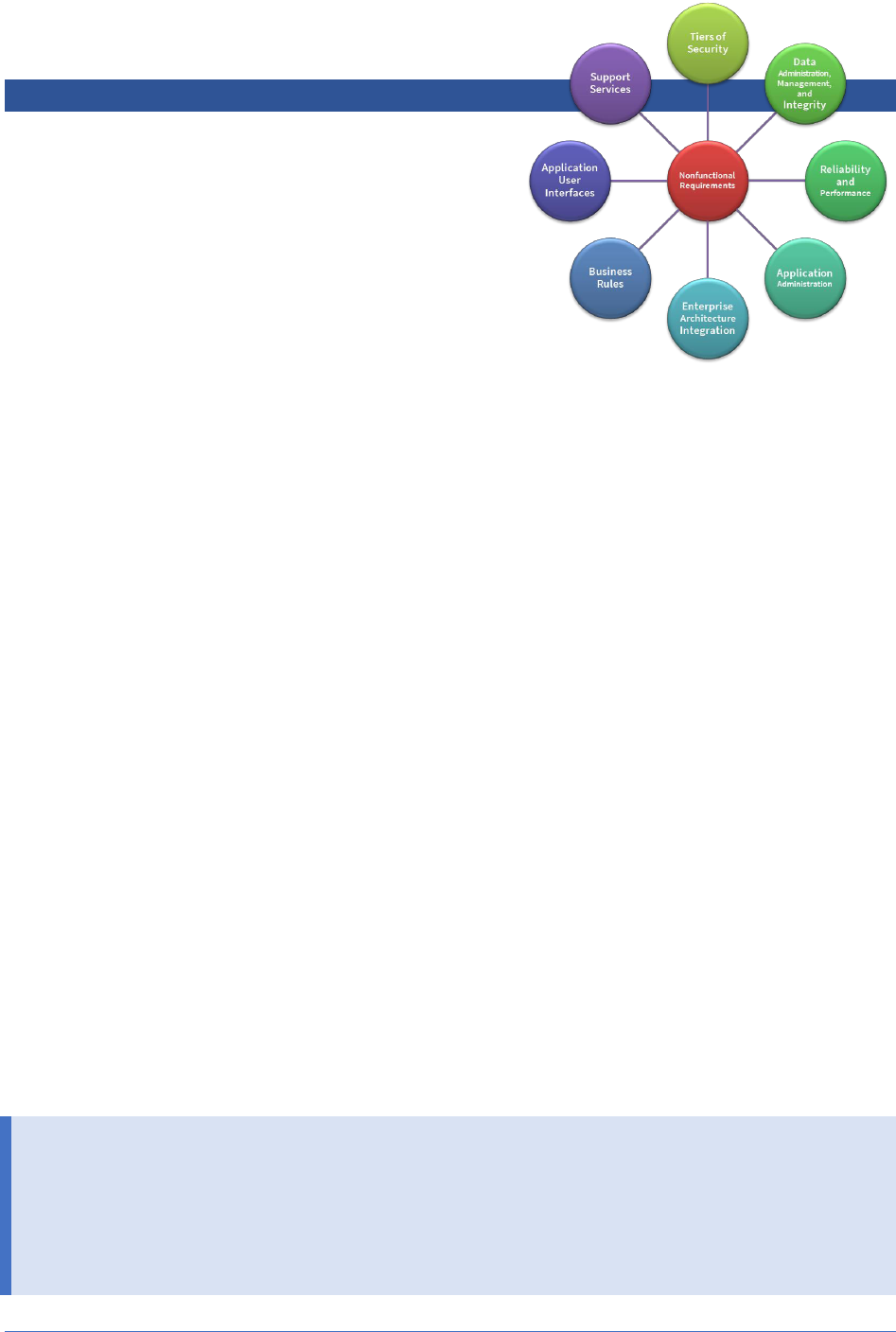
PCMS Functional Requirements 87
Section 8: Nonfunctional Requirements
Nonfunctional requirements describe the capabilities
needed to manage the environment of a business system.
These capabilities, which are used by system and database
administrators, address the deployed environment of the
business application. They are:
Tiers of security
Data administration, management, and integrity
Reliability and performance
Application administration
Enterprise architecture integration
Nonfunctional requirements also describe the capabilities that are needed to manage the PCMS application.
These capabilities address the business application itself and are used by the application administrator:
Business rules
Application user interfaces
8a. Tiers of Security
The goal of system security is to protect personal identifying information from being compromised. It is the
responsibility of the prosecutor to ensure that information is secure and only provided to authorized entities
through acceptable means. The PCMS application should be implemented within a secure network with
firewalls and network security measures in place. In addition to the physical and transport layer security, the
application should allow for tiered security.
At the first tier, the PCMS application needs to be secured from inappropriate access, both from within the
organization and by external users. This is generally accomplished through system userids, passwords, and
two-factor identifiers—depending upon the criticality or sensitivity of the business application. The PCMS
application ideally would integrate with the systems technique of enterprise user identification.
At the second tier, the PCMS application needs to secure the access privileges to services and actions upon
data by users. This is generally accomplished by assigning roles to persons, with each role having a set of
privileges through a configurable process of user table maintenance. Examples of roles would be
application administrators, agency management, agency supervisors, agency prosecutors, agency staff, and
general users.
A third tier of security involves the interactions of the PCMS with external systems. Considerations for this
security entail endpoint digital public key certificate exchanges and encrypted messages during transport.
This ensures that the senders and receivers are legitimate, are current system participants, and adhere to
enterprise security policies.
PCMS Security Capabilities offer the ability to—
create and assign user accounts
create and associate user accounts to PCMS roles
create and associate business rules to PCMS roles
create and associate PCMS service and data access privileges to PCMS roles
integrate with external user identity authentication services

PCMS Functional Requirements 88
8b. Data Administration, Management, and Integrity
Data administration is the capability to establish and maintain the PCMS’s underlying information model, a
framework that establishes a data hierarchy of data groups, categories within groups, and elements within
categories. (Note: These terms may differ depending on the database platform.) Based on the system’s
functional characteristics, it should have a “master table” information structure with groups that describe
persons, organizations, cases, locations, activities, documents, and events. As an example, a person group
could be attorneys, with categories of prosecutors and defense attorneys using data elements that describe
their name, contact information, jurisdiction, and digital identity. The data administrator should be able to
add and maintain these groups and their associated data field characteristics without compromising the
integrity of the information model. Data characteristics are both physical and logical:
Physical characteristics describe the field name, size,
and type of data, and associated rules, e.g., “Person
First Name,” 12 characters long, text data, and the field
is required.
Logical characteristics describe the relationships
between groups, categories, and data elements. For
example, a case must be associated with a jurisdiction,
and it must have an attorney, a case number, a
defendant, and a charge.
Although this document does not detail a PCMS information model, it is critically important for the evaluating
team to assess the candidate PCMS application’s model against the mandatory and optional functional
characteristics of screen designs, document templates, queries, reports, and workflow. This is an extensive
task, which should involve both business subject matter experts and technical data administrators.
Data management and integrity practices ensure that data are accurate and protected, and that database
referential integrity is ensured. As PCMS functional components are configured, the PCMS should continually
validate and ensure that data relationships are accurate and complete. Ideally, validation should occur real-
time as components are configured; alternatively, and in addition, the system should generate data
validation reports. The PCMS should also be able to generate data relationship diagrams and data dictionary
reports based on the configured components.
Data management includes the ability to back-up active databases for redundancy and recovery, and create
archive databases for historical recordkeeping. These are generally performed by database administrators at
the schema level and system administrators at the program and operating system level. It is important to
ensure that back-ups for both the application and database are taken at the same time to facilitate
compatible recovery. Too often, back-ups are only taken at the database level and if restored, are likely to be
incompatible with the application.
PCMS Data Administration, Management, and Integrity Capabilities offer the ability to—
design, configure, and maintain the underlying information model (including user-defined fields)
configure and maintain templates for screens, documents, and forms
validate the underlying information model and associated templates (preferably real-time during configuration
activities)
generate data dictionary reports and data relationship diagrams
create scheduled and ad-hoc database back-ups, including full, partial, and change-only back-ups
restore database back-ups
archive data without compromising the integrity of the active data
retrieve archived data
mark an element as sensitive or confidential to support redaction requirements
generate scheduled and ad-hoc data activity and audit logs

PCMS Functional Requirements 89
Data management may also include capabilities to:
update case status and information for both individual cases and groups of cases
create and print reports for multiple cases
print checks for multiple cases
merge cases
merge defendants
8c. Reliability and Performance
Reliability is a coupling of system availability, maintainability, and performance. Reliability is a consideration
for, but does not include Disaster Recovery or Business Continuity plans.
System availability measures the time that a system functions without broad outages or component errors,
commonly referred to as “bugs.” Service level agreements document the PCMS system availability needs for
users. System availability is usually expressed and measured in system access “up-time” requirements, time
for data updates to take effect, “down-time” requirements for data and application back-ups, and system
recovery times in the case of a broad system outage. A broad statement, such as “System should be available
24 hours, 7 days a week,” is essentially unrealistic and should be broken down by components, workflow
priorities, and critical paths of the business.
Service level agreements also document the PCMS system performance needs for users. Performance is
generally expressed in metrics for online and offline activities response times. Similar to system availability
statements, broad performance statements, such as “Response time for all transactions should be less than 3
seconds,” are unrealistic. Broad query criteria against large databases will result in long-running queries,
whereas a specific query against a key identifier will return faster results. Another aspect of performance is
navigation—how long does it take to enter a case? How long does it take to add witnesses to the witness list?
How long does it take to navigate to the victim list? Is required information really required at entry? Specific
statements, such as “A case by jurisdiction query should return results within 5 seconds” or “Entry of
mandatory fields of a single-charge new case should take less than 5 minutes” are of more value to measure
performance.
Maintainability is the ease and speed with which a system outage or problem can be identified and resolved.
Maintainability is usually expressed and measured in “Mean Time to Repair,” which includes staff response
and resolution times based on severity. Service level agreements document PCMS maintainability through
defining problem severity levels. Definitions usually consider the extent of the user impact, the frequency of
the problem, and the impact to business processes.
Reliability Capabilities offer the ability to—
define measurements and service level agreements for discrete PCMS components
measure and collect response times for discrete PCMS components
measure and collect system availability for discrete PCMS components
log errors
create application “dumps” when errors occur
define notifications when errors occur
send alerts when errors occur

PCMS Functional Requirements 90
8d. Application Administration
PCMS components and functions should be configurable in order to meet an agency’s current requirements
and new or changing requirements over time. The PCMS configuration framework should be flexible and
customizable, yet maintain application integrity as components are reconfigured. This set of functions allows
application administrators the ability to customize features and functionality to meet the needs of the
prosecutor’s office. This includes custom data fields, data entry screens, interfaces, forms, and reports.
In many cases, the vendor needs to provide user and technical documentation so the agency can administer
the application. This documentation should provide guidance and instructions, including:
The capabilities implemented – the attributes, characteristics and qualities of the system.
Environmental and architecture requirements – database platform, server requirements, etc.
How to customize and configurable user-defined fields, forms, and reports.
How to configure system to system interfaces.
Manuals for the end-users.
8e. Enterprise Architecture Integration
Many prosecutors’ offices rely on county, city or other entities for IT support. This support is frequently
approached through an Enterprise Architecture (EA) strategy, which provides sets of reusable standardized
services. The EA strategy may dictate that application solutions comply within the standard services. So, in
addition to the functional standards, the PCMS solution assessment should include the capability of the PCMS
to integrate into the enterprise services.
Enterprise Network Services provide the communication infrastructure between locations, facilities, and
systems, as well as connectivity to law enforcement, courts, and other justice services. The PCMS should not
require any custom configurations; instead, it should be “network agnostic” and capable of using supported
network protocols for security, reliability, functionality, and information sharing.
Enterprise Hosting Services provide the hardware and system software infrastructure—servers, database
storage, operating systems—to support the PCMS environment. The PCMS should be capable of operating in
a variety of hosted environments, whether local servers, enterprise servers, or cloud-based environments.
PCMS user interfaces should be deployable on a variety of devices, e.g. desktops, laptops, and tablets.
Enterprise Data Services provide technology offerings for data storage, access, availability, and security. The
database selections likely include mainframe, middleware, and local server databases. Data access services
provide query and search capabilities. Data availability services provide data back-up, restore, archive, and
recovery capabilities. Data security services provide encryption capabilities for data at-rest and in-motion and
protection against malicious actors and data theft.
Enterprise Business Services provide business technology offerings, such as document management, data
analytics and visualization, secure financial transactions, and user identity management. Users should closely
examine these for compatibility and integration with the PCMS, as they can extend the business productivity
and efficiency.

PCMS Functional Requirements 91
Enterprise Architecture Capabilities offer the ability to—
use the enterprise network protocols without customization
deploy on the supported enterprise hosting infrastructure
deploy on the supported enterprise data technologies
deploy on common user devices, including mobile devices
leverage and integrate with enterprise business technologies
8f. Business Rules
Business rules define operational logic between data values and processing. They are distinct from field
validation rules, which can be validated through the information model. (A simple field validation example is
that any “State” field is validated against the “State Abbreviation” table.)
Business rules are used in screen navigations, workflow traversals, query, search and report results, and
many other aspects. Business rules and the information model are arguably the most complex design
activities for any business application; for a PCMS, given the potential impact upon defendants and the public,
they need to be given the utmost attention.
Many business rules are simple:
When a defendant is entered, the date of birth must also be entered.
If a driver’s license number is entered, the issuing state must also be entered.
For the date of birth rule, a screen will enforce that a date of birth is entered. As simple as these two
unrelated rules seem, if the rules are not designed in conjunction with the information model, problems will
arise. The term “when” implies that the data object is required. Hence, a screen navigation rule will enforce
that a date of birth is entered. What if the date of birth is unknown? The information model can create an
unknown date default, such as 01/01/1900. For a driver’s license, the term “if” implies that the data object is
optional. However, the issuing state would not be optional if the driver’s license number is entered. This
could be enforced through the information model, but probably better enforced through the screen
navigation template.
Many business rules are complex and inter-related with simple rules:
1. If the defendant is less than 17 years old at the time of the offense, the defendant is a juvenile
(simple rule) but
2. If the charge is a Class A Felony, and
3. There are criminal enhancers, then
The case and defendant must be handled as an adult matter.
This example needs person and charge data attributes to arise at a decision, but can only be enforced
through business logic.
Business Rules Capabilities offer the ability to—
create business rules against specific fields
create business rules that validate values across multiple rules
integrate business rules in the design of screen templates
integrate business rules in the design of screen navigation
integrate business rules in the design of document forms

PCMS Functional Requirements 92
8g. Application User Interfaces
Application user interfaces are typically enabled through presentation screens that allow users to use the
business functions of the PCMS. These business functions, fully described in the Case Management and
Tracking Functional Requirements sections 1 through 7, include capabilities to enter, access, and query data,
to participate in workflows, and to review and route documents. The nonfunctional capabilities for
application user interfaces allow application administrators to design, configure, and customize the PCMS.
A well-designed user interface is efficient, user-intuitive, and easy to navigate. It should make logical sense in
the sequence of activities and create the correct business outputs. Training requirements should be minimal.
Application User Interfaces Capabilities offer the ability to—
design fields with user-friendly business names
associate business rules with data fields
associate fields with screens
create conditional field-to-field navigations
create a screen-to-screen workflow
create conditional screen-to-screen workflows
create a person-to-person workflow
create conditional person-to-person workflow
create notifications when certain events occur
create field-level “help” content, e.g. “hover hints”
create on-demand training content
8h. Support Services
An event is a detectable or discernible occurrence that has significance for managing the IT infrastructure or
delivering the services. The PCMS should provide system administrators with tools to monitor and detect
events before they become unplanned interruptions to IT services or a reduction in the quality of service.
1. System Resilience – This is the system’s ability to maintain acceptable service levels.
The hosting entity or solution provider should take steps to reduce the probability of system failures
and unplanned outages (e.g., load balancing servers to prevent overloads, providing redundancies to
avoid single points of failure).
The hosting entity or solution provider should be able to identify potential vulnerabilities and take
steps to address them.
The hosting entity or solution provider should be able to detect system problems as they occur and
take prompt steps to remediate any issues (e.g., monitoring physical servers and specific
applications/services).
2. Disaster Recovery/Failover – In the event of manmade and/or natural disasters, the hosting entity or
solution provider should have an effective recovery plan to return the system to a steady state in a timely
manner with a minimal amount of data loss. The system should have a secondary failover site to allow
for continuity of operations until the system can be restored in its primary environment.
3. User Support – The PCMS vendor should provide online and phone-based technical assistance services
during predetermined hours (e.g., 0700 to 1800 EDT). If patches and upgrades are part of the licensing
and/or maintenance agreement, they should be applied outside of normal office hours. All patches and
upgrades should be tested prior to deployment in a production environment, and the vendor should be
able to roll back any system changes in the event the system becomes unstable or inoperable.

PCMS Functional Requirements 93
Appendix A: Document Terms and Definitions
A
Adjudication
The act of a court in making an order, judgment, or decree, judicial decision,
or sentence.
Adjudication hearing
A trial for a juvenile offender heard by judges because youthful offenders do
not have the right to a trial by a jury of their peers.
Appeal
Application to a higher court for a reversal of the decision of a lower court.
Arraignment
A formal reading of a criminal charging document in the presence of the
defendant to inform the defendant of the charges and provide the defendant
an opportunity to enter a plea.
Arrest
The act of seizing someone into custody.
Bail
The release of an accused person, usually on condition that a sum of money
be lodged as guarantee they appear in court. The court sets the bail amount
and release conditions.
B
Bail Bond
An instrument of indebtedness or written promise signed by an accused and
surety agent to ensure the accused will appear in court.
Brady v. Maryland
(1963)
U.S. Supreme Court decision requires that the prosecutor disclose
exculpatory evidence.
C
Civil forfeiture
The legal process in which law enforcement officers seize assets; sometimes
referred to as “asset forfeiture.”
Criminal case (Case)
Prosecution by the State of a person or organization, for committing a crime
punishable by law.
Charge
A formal accusation made by a governmental authority asserting that a
person committed a crime.
Charging document
A formal document that contains one or more criminal charges or counts,
which can take several forms, including: complaint, indictment, or
information.
Citation
A summons to appear before a court at a specific place and time to answer
to specific charges.
D
Defendant
The subject of a criminal, traffic, or infraction prosecution.
Delinquent
A juvenile defendant.
Delinquent acts
Juveniles commit “delinquent acts” instead of “crimes,” which may include
status offenses.
Digital signature
A digital signature is contained in a digital certificate, which is an electronic

PCMS Functional Requirements 94
document from a certificate-issuing authority that binds together a public
key with an identity and can be used to verify a public key belongs to a
particular person or entity.
Digitized signature
A scanned image of a handwritten signature.
Disposition
Refers to the final determination of a case or issue as determined by a
prosecutor or court.
Docketing
Refers to creating and maintaining a list of judicial proceedings for court
schedules.
E
Evidence
The available body of facts or information indicating whether a belief or
proposition is true or valid.
Extradition
Sometimes referred to as “interstate rendition” — one state or nation giving
over an individual to another state or nation for purposes of criminal trial or
punishment.
G
Giglio v. United States
(1972)
U.S. Supreme Court ruling that requires the prosecutor to provide the
defense with any information related to the credibility of the prosecutor’s
witnesses.
Giglio list
A term used to define a list of potential witnesses with credibility issues; it
includes both Brady and Giglio disclosures. For example, a police officer who
fabricated evidence in the past or a witness who received deferred
prosecution for testimony.
H
I
J
Hearing
Opportunities to state facts, seek judgments, or request event changes in
court.
Infraction
A violation or infringement of a law—an infraction is usually used to describe
a minor offense.
Jurisdiction
The geographical boundary within which the prosecutor’s authority extends.
Juvenile
A young person who is the subject of a criminal investigation.
N
O
Nonrepudiation
practices
Methods to ensure that the user is who they say they are; for example,
fingerprint authentication, tokens, and digital certificates.
Offender
An individual who breaks the law.
Offense
As distinguished from charge. Offense information is related to the law
enforcement incident and arrest data underlying the criminal case and
includes law enforcement identifiers and elements of the offense, such as
the date of offense.
Omnibus hearing
Pretrial hearing to determine the evidence, including testimony and evidence
seized at the time of arrest, does not violate the defendant’s rights.

PCMS Functional Requirements 95
P
Participant
Any individual involved in a case outside of the established roles, such as
judge, attorneys, witnesses, victims, defendants, etc. This can include
investigators, support staff, interpreters, victim advocates, diversion officials,
etc.
Probable cause
A requirement found in the Fourth Amendment that must usually be met
before police make an arrest, conduct a search, or receive a warrant. It is the
sufficient reason based upon known facts to believe a crime was committed
or that certain person(s) and/or property is connected with a crime.
Property
A thing or things belonging to someone; possessions collectively.
Prosecutor
Unless otherwise specifically indicated, means any person or persons
performing the prosecution functions—Prosecutor, County Attorney, District
Attorney, Special Prosecutor, Prosecutor staff, etc.
R
S
Restitution
Recompense for injury or loss.
Speedy trial
The Sixth Amendment guarantees all persons accused of criminal
wrongdoing the right to trial without undue delay.
Suspect
A person of interest to a criminal investigation.
Status offense
A noncriminal act that is considered a law violation only because of a
youth's status as a minor. It is often resolved at the investigating agency.
V
W
Victim
A person harmed, injured, or killed as a result of a crime, accident, or other
event or action.
Witness
A person who sees an event, typically a crime or accident, take place.

PCMS Functional Requirements 96
Appendix B: Resources
Alaska Court System, Clerk’s Manual Criminal, Sixth Revision March 1998
American Bar Association, Prosecutor Functions:
https://www.americanbar.org/publications/criminal_justice_section_archive/crimjust_standards_pfunc_
blk.html
American Bar Association Prosecutor Standards. Fourth Edition:
http://www.americanbar.org/groups/criminal_justice/standards/ProsecutionFunctionFourthEdition.html
American Probation and Parole Association, Functional Standards Development for Automated Case
Management Systems for Probation, September 2003
Chelan County Washington Prosecuting Attorney Case Management System (PCMS) RFP/Q, Released
December 15, 2014
County of Prince Edward, Virginia, Request for Proposal for a Case Management System RFP13-001
County of San Luis Obispo (California), Request for Proposal, District Attorney Case Management System,
2012
Civil forfeiture policy and guidelines: https://www.justice.gov/criminal-afmls/file/839521/download
Federal Rules of Criminal Procedure,
http://www.uscourts.gov/sites/default/files/federal_rules/FRCrP12.1.2014.pdf, December 1, 2014, U.S.
Government Printing Office, Washington DC
FindLaw Criminal Law online resource: http://criminal.findlaw.com/
FindLaw Juvenile Justice proceedings: http://criminal.findlaw.com/juvenile-justice/how-do-juvenile-
proceedings-differ-from-adult-criminal-proceeding.html
Guardianship: http://www.familylawselfhelpcenter.org/self-help/guardianship/overview
Law Enforcement Information Technology Standards Council, Standard Functional Specifications for Law
Enforcement Records Management Systems, version II
Montana Criminal Law and Procedure: http://courts.mt.gov/portals/113/library/bar-
seminar/docs/criminal-law.pdf
The National Consortium for State Court Automation Standards, Criminal Functional Standards, 2002
National District Attorneys Association, National Prosecution Standards. Third Edition with Revised
Commentary http://www.ndaa.org/pdf/NDAA NPS 3rd Ed. w Revised Commentary.pdf updated 2009
Nolo online Legal Encyclopedia: www.nolo.com/legal-encyclopedia
Oregon State Bar Association, Juvenile Dependency procedures:
https://www.osbar.org/_docs/resources/juveniletaskforce/JTFR3.pdf
Wisconsin Department of Administration, Prosecutor Case Management Solution Request for
Information (RFI) 20866-AW-RFI Issued: February 4, 2011

PCMS Functional Requirements 97
Appendix C: Cross-Reference Matrix
FUNCTIONS
Mandatory
Desired
Optional
In Current PCMS
Pretrial
Case Initiation
Initial Appearance
In-Custody Defendants
Preliminary Hearing
Arraignment
Pretrial Events
Trial
Jury Selection
Trial Preparation and Presentation
Jury Instructions
Verdict and Finding
Post-Adjudication
Case Disposition
Sentencing
Other Post-Adjudication Events
Special Cases
Citation/Infraction
Grand Jury
Juvenile
Civil Forfeiture
Insufficient Funds Cases
Guardianship
Child Dependency and Neglect
Special Prosecution
Appeals
Case Support and Services
Discovery
Evidence Management
Investigations
Motions
Victim Services/Assistance

PCMS Functional Requirements 98
Restitution and Compensation
Management
Witness Management
Diversion/Deferred Prosecution
Additional Business Requirements
No Contact and Protection Orders
Warrant Reviews
Extradition
Conflict Avoidance
Common Requirements
Data Exchanges/System Interfaces
Records and Document Management
Workflow Management
Time Tracking
Data Analytics and Performance
Management
Nonfunctional Requirements
Tiers of Security
Data Administration, Management,
and Integrity
Reliability and Performance
Application Administration
Enterprise Architecture Integration
Business Rules
Application User Interfaces
Support Services

PCMS Functional Requirements 99
Appendix D: Data Management – Data Groups
The following is a list of all data groups and detailed business data elements required of a PCMS.
Agency
Arrest
Bail and Bond
Booking
Case
Name
Date/time
Bail amount
Arrest
Identifier
Identifier (ORI)
Arrest tracking number
(ATN)
Conditions
Agency
Name
Location
Arresting (Agency)
Bond status
Date/time
Severity (felony,
misdemeanor, etc.)
Contact (Person)
Charge
Bond type (Property,
Surety, Case, etc.)
Booking identifier
Status
Defendant (Person)
Case
Defendant details
Style
Location
Court
Charge
Court dates
Court
Date
Date updated
Defendant (Person)
Filing (Agency)
Fair market value of
property
Judge (Person)
Property (Location)
Defense attorney
(Person)
Property description
Referencing (Agency)
Surety owner (Person)
Domestic violence
indicator
Charge
Court
Defendant detail
Disposition
Event
Count
Identifier (ORI)
Age
Court
Court
Description
Name
Date of birth
Date
Date
Identifier
Type
Driver license or state-
issued ID number (DLN)
Defendant (Person)
Name
Severity
Jurisdiction
Ethnicity
Description
Results
Type
Location
Eye color
Disposition type
Type
Statute identifier
FBI Universal Control
Number (UCN)
Plea information
Location
Statute description
Gender
Sentence
Time
Hair color
Height
Marital status
Minor or adult indicator
Occupation
Passport number
Race
Physical descriptions
Sex
Social security number
(SSN)
State identification
number (SID)
Weight
Custody status

PCMS Functional Requirements 100
Evidence
Incident
Location
Person
Property
Access by
Defendant (Person)
Address
Bar number *optional
Description
Blood alcohol level
Evidence
City
Email addresses
Identifier
Date/time access
Gang-related
Latitude and Longitude
Location
Location
Date/time release
Hate/Bias code
Description
Name
Owner (Person)
Discoverable indicator
Incident date
Type
Person role
Type
DUI intoxicant type
Incident description
State
Phone numbers
Value
Evidence description
Incident number
Zip code
Work (Location)
Evidence identifier
Location
Evidence type
Offense
attempted/completed
Seizure (Location)
Offense codes
Measurement
Offense descriptions
Released to (Person)
Offense types
Submitter (Person)
Property type
Property value
Type of criminal activity
Victim
Victim statements
Weapons used
Witness statements
Sentence
Task
Victim
Warrant
Witness
Charge
Assigned to (Person)
Age
Affiant
Items to produce
Concurrent or
consecutive
Date assigned
Person
Affiant (Agency)
Person
Date
Date due
Race
Charge
Relationship with
offender
Fees imposed
Description
Relationship with
offender
Court
Subpoena type
Fines imposed
Status
Sex
Court case number
Brady/Giglio indicator
Presentence
investigation report
Type of injury
Date issued
Brady/Giglio information
Restitution imposed
Type
Judicial officer (Person)
Sentence length for each
charge
Narrative
Sentence sanctions
Subject (Person)
Sentence type for each
charge
Subject (Defendant
details)
Verdict
Vehicle (plate, make,
model, description)
Status

PCMS Functional Requirements 101
Endnotes
i
National District Attorneys Association, National Prosecution Standards. Third Edition with Revised Commentary,
updated 2009: https://ndaa.org/wp-content/uploads/NDAA-NPS-3rd-Ed.-w-Revised-Commentary.pdf.
ii
Appendix B provides a list of resources.
iii
Federal Plain Language Guidelines, Rev. 1, May 2011, at p. 25:
https://plainlanguage.gov/media/FederalPLGuidelines.pdf.
iv
In some jurisdictions, the police may make initial charging decisions when requesting an arrest warrant.
v
The time differs depending on jurisdiction. The Sixth Amendment to the U.S. Constitution provides that “in all
criminal prosecutions, the accused shall enjoy the right to a speedy trial.” The U.S. Supreme Court in County of
Riverside v. McLaughlin (1991) ruled that a suspect arrested without a warrant must appear before a judicial
officer and be informed that there is probable cause that a crime has been committed and the individual has
committed the crime within 48 hours. However, many states have added statutes, constitutional amendments, or
rules of criminal procedure that require an offender in custody to appear in court within 24 hours of being
detained, while others may be up to 72 hours.
vi
Appendix D lists all data groups and detailed business data elements required of a PCMS.
vii
Federal Rules of Criminal Procedure, December 1, 2014, Rule 5. Initial appearance:
http://www.uscourts.gov/sites/default/files/federal_rules/FRCrP12.1.2014.pdf.
viii
Speedy trial standards:
https://www.americanbar.org/publications/criminal_justice_section_archive/crimjust_standards_speedytrial_blk.
html Part II.
ix
Sentencing standards:
https://www.americanbar.org/publications/criminal_justice_section_archive/crimjust_standards_pfunc_blk.html
Part VII.
x
Overview of asset forfeiture: http://apps.americanbar.org/buslaw/blt/content/2012/06/article-02-dery.shtml.
xi
A defense attorney may file a preservation of evidence request (usually it happens at first appearance) with the
Court. The moment that is filed, the prosecution and law enforcement is on notice that everything related to the
case must be preserved, including 9-1-1 tapes, notes, recordings, etc.
xii
Restitution and compensation: http://victimsofcrime.org/library/publications/restitution-and-
compensation/restitution-toolkit.
xiii
http://criminal.findlaw.com/criminal-procedure/extradition.html.
xiv
18 U.S.C. § 3182 specifies 30 days, but some states may allow longer waiting/holding periods:
https://www.gpo.gov/fdsys/pkg/USCODE-2015-title18/pdf/USCODE-2015-title18-partII-chap209-sec3182.pdf.
xv
Brady disclosure: https://en.wikipedia.org/wiki/Brady_disclosure.
xvi
IACP National Law Enforcement Policy Center, Brady Disclosure Requirements, Model Policy, April 2009.
xvii
A digital certificate is an electronic document issued by a Certificate Authority (CA). It contains the public key for
a digital signature and specifies the identity associated with the key. By default, date and time are included with
a digital signature. A digitally-authorized time stamp indicates that the contents of any data file existed at that
time and have not changed since then.
